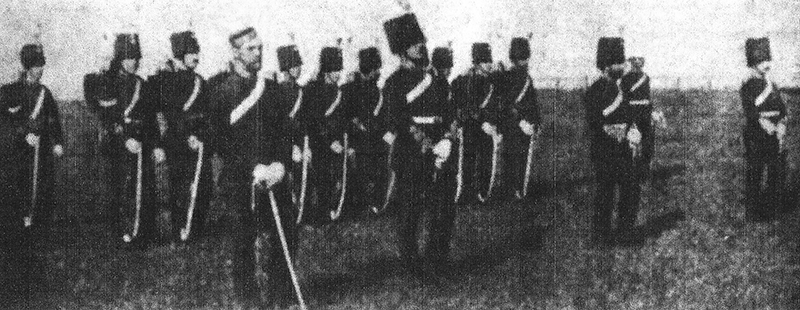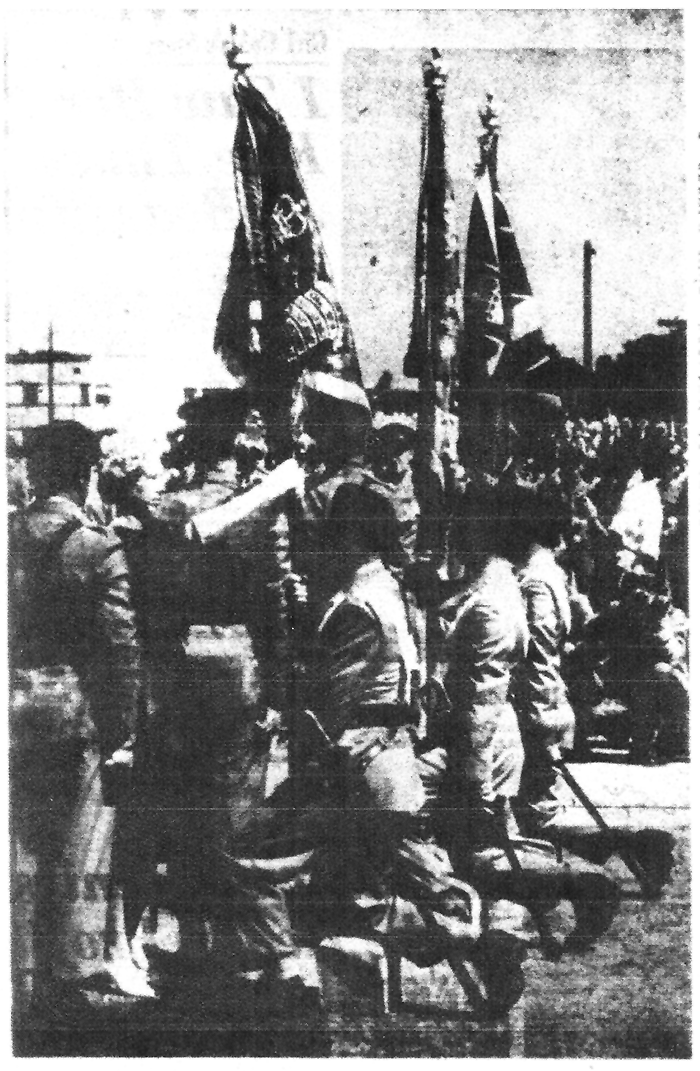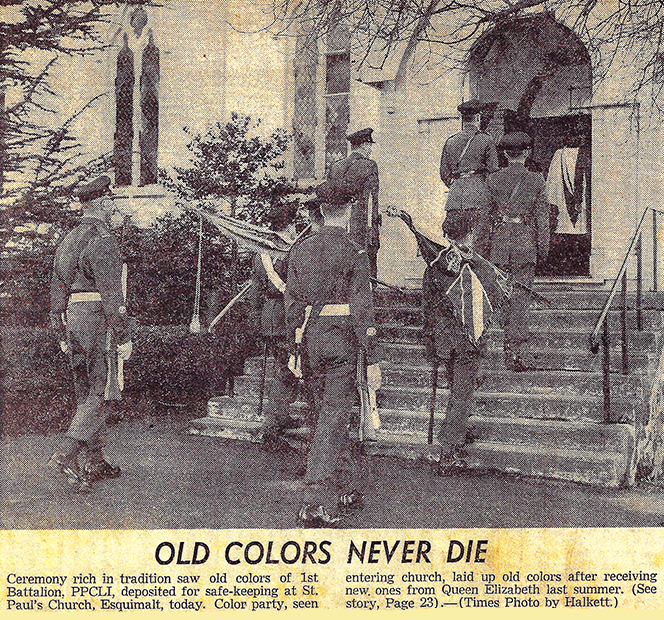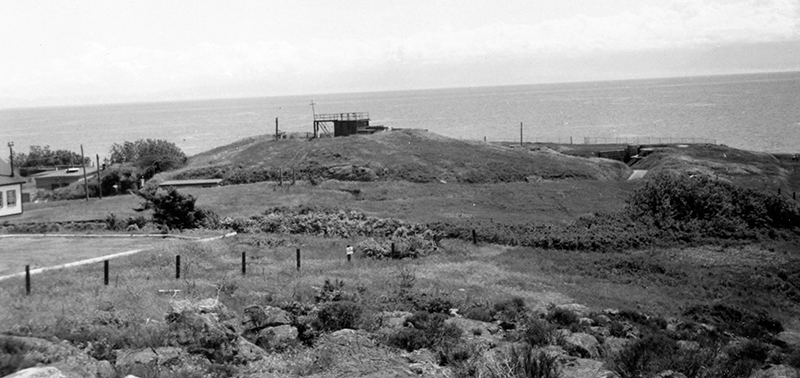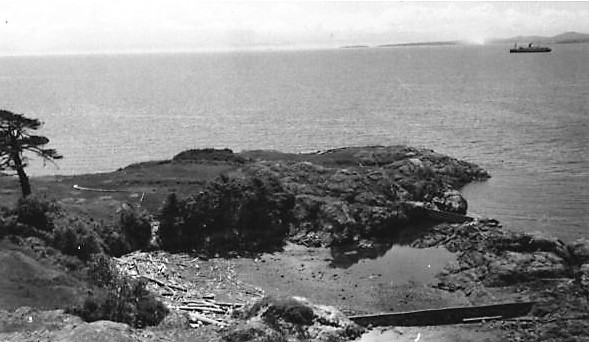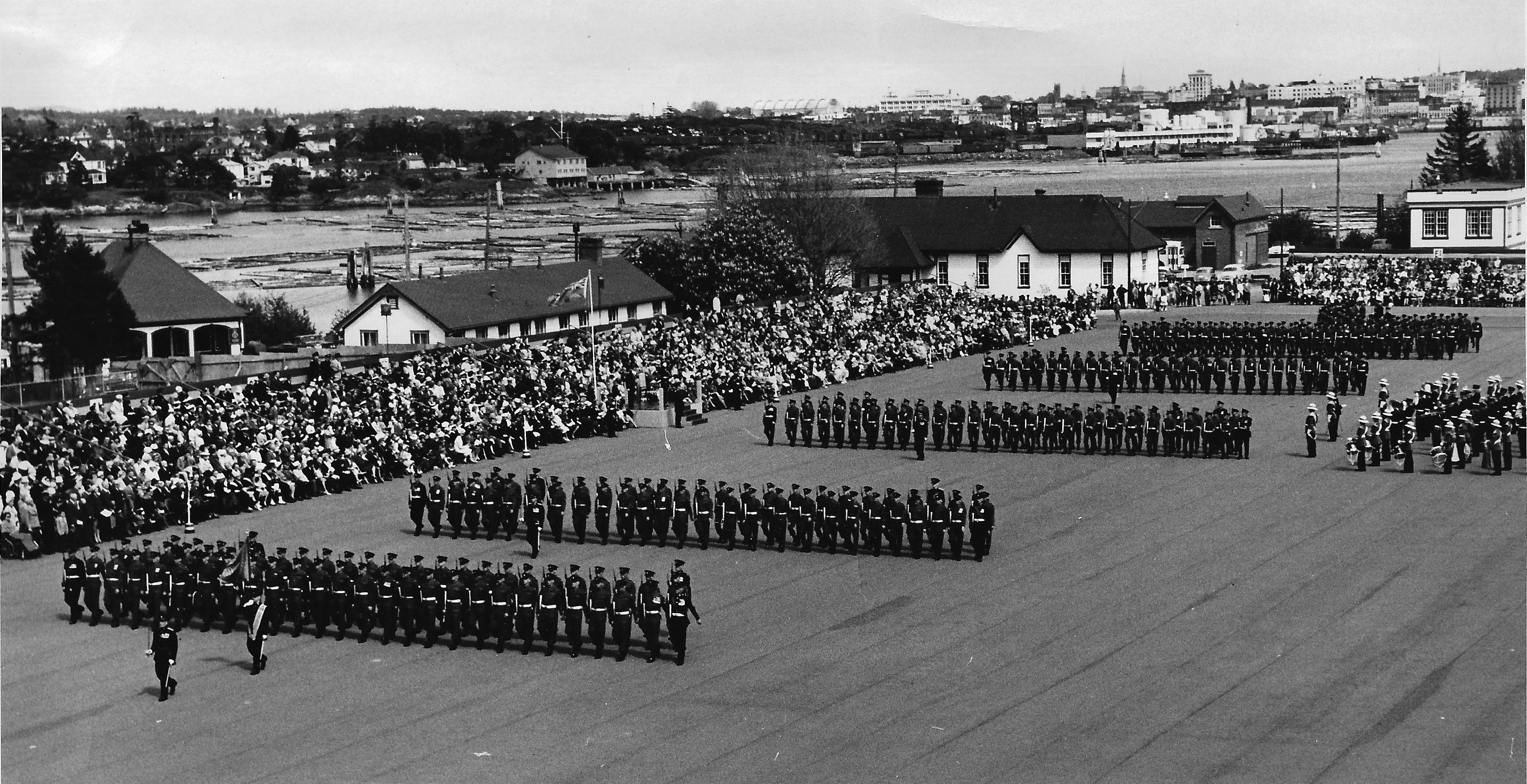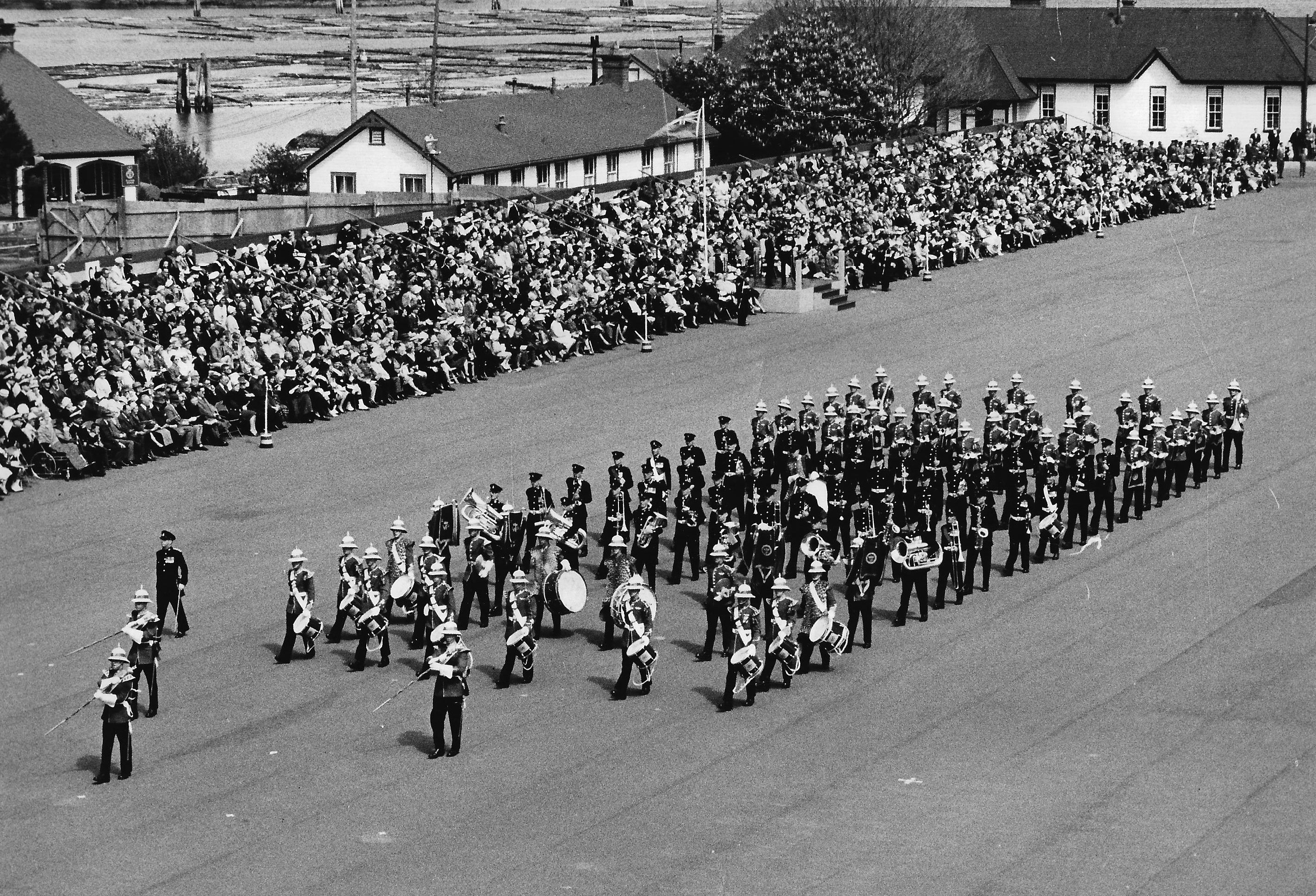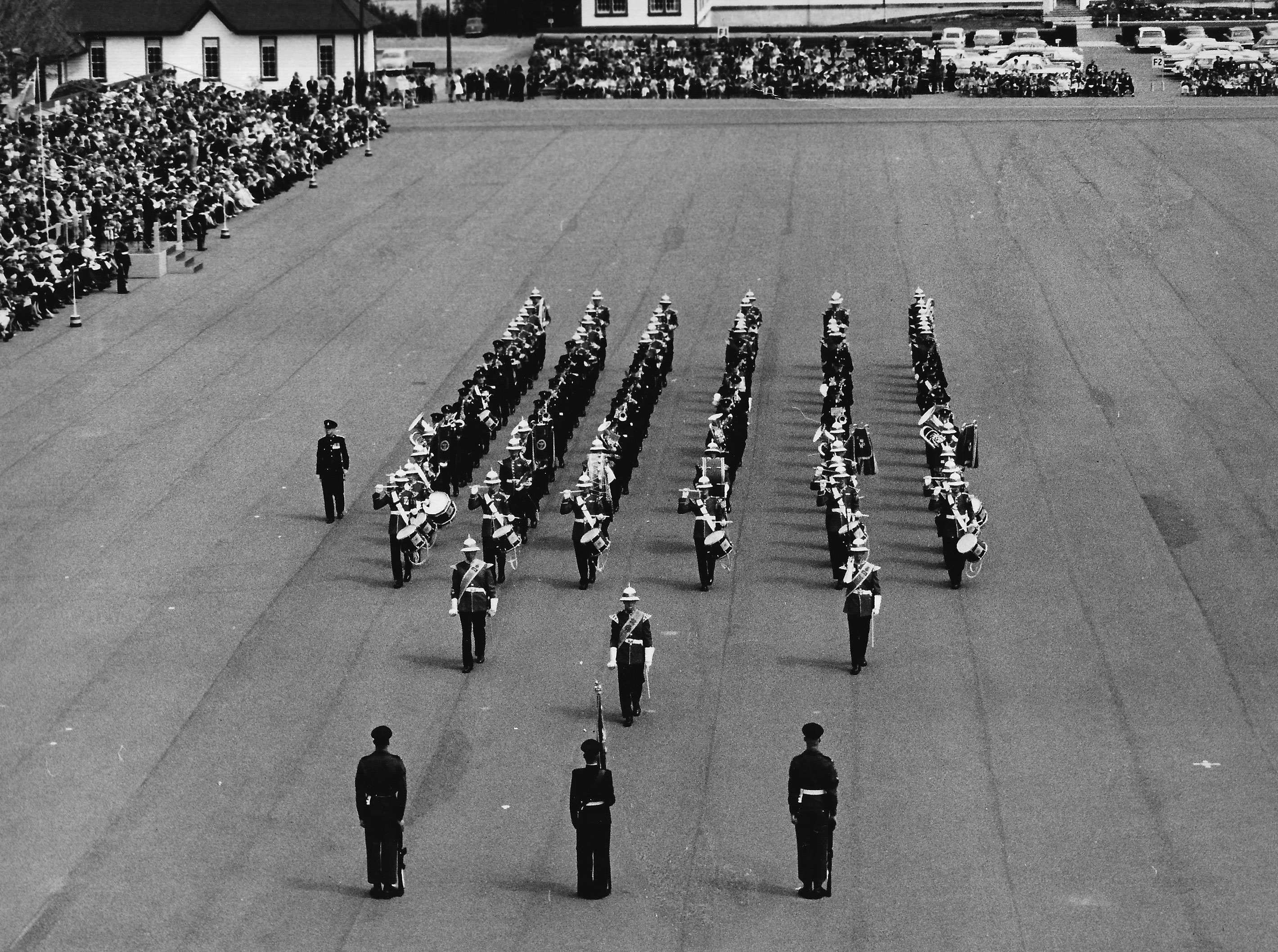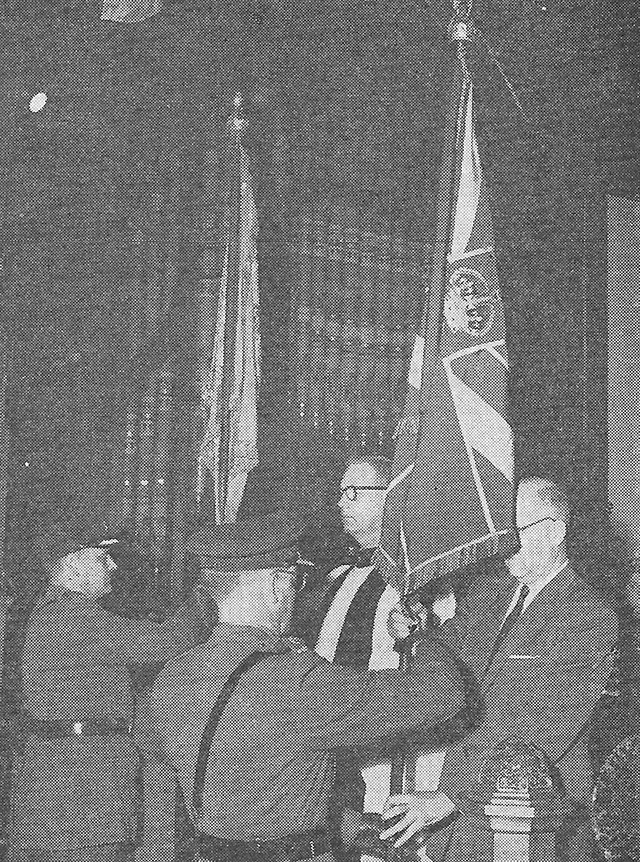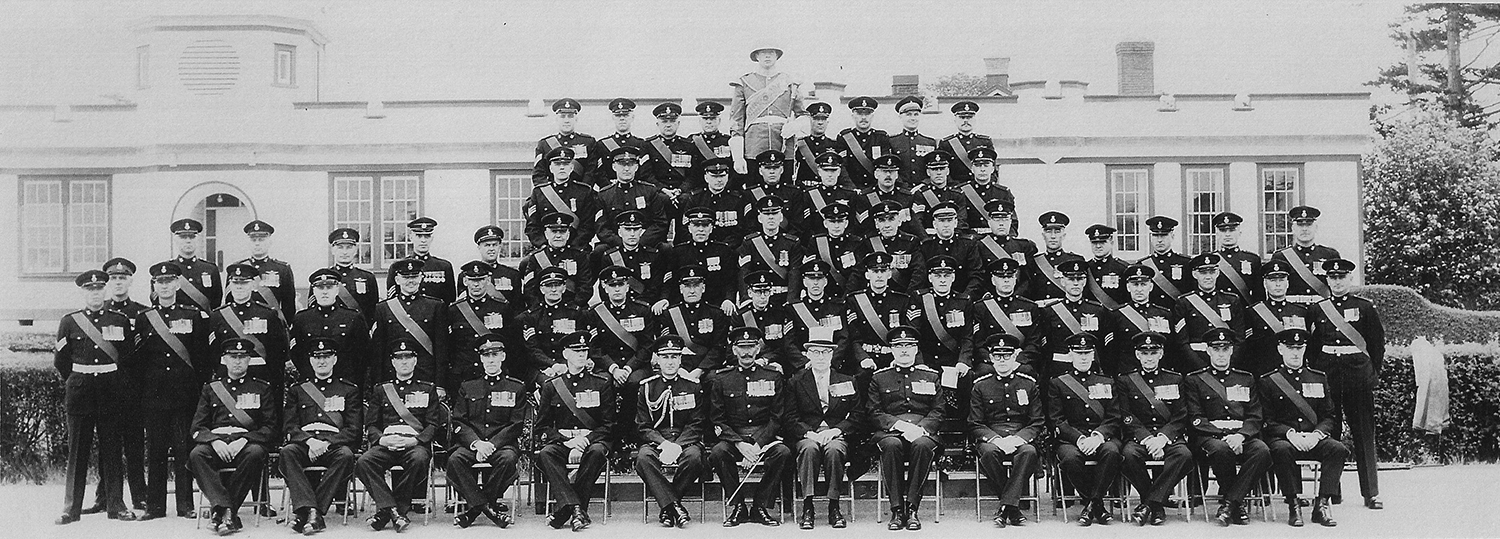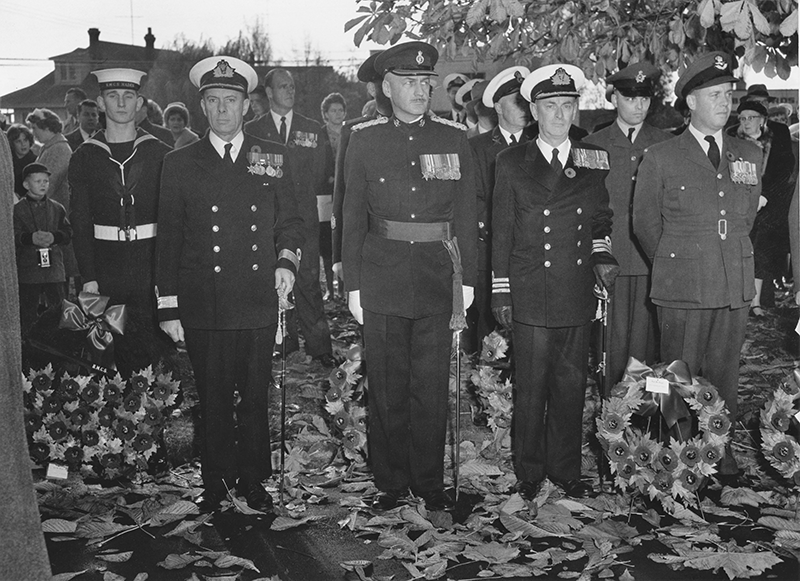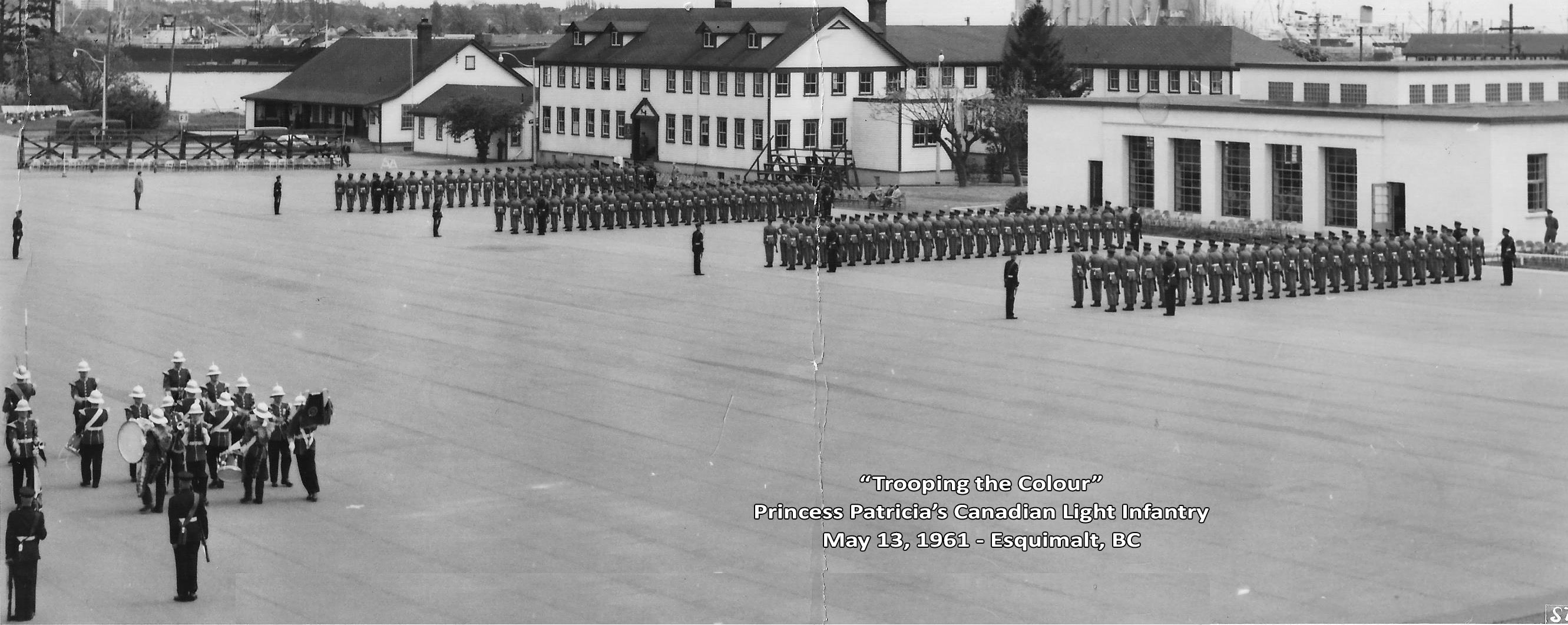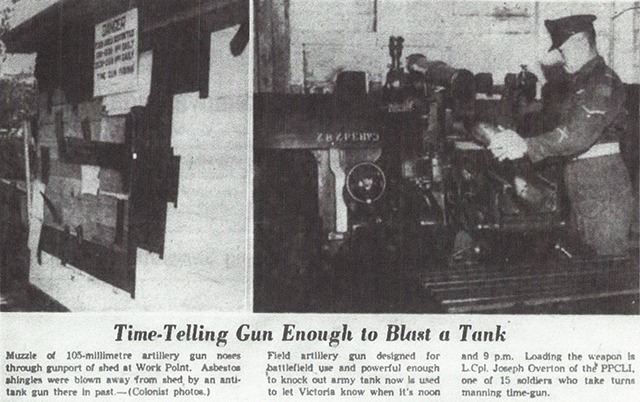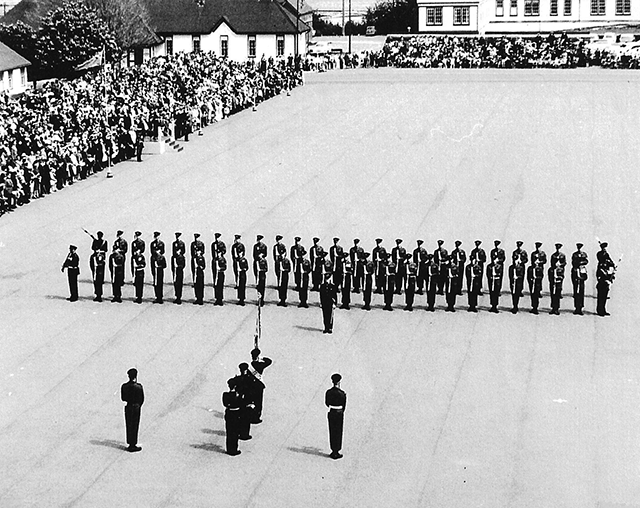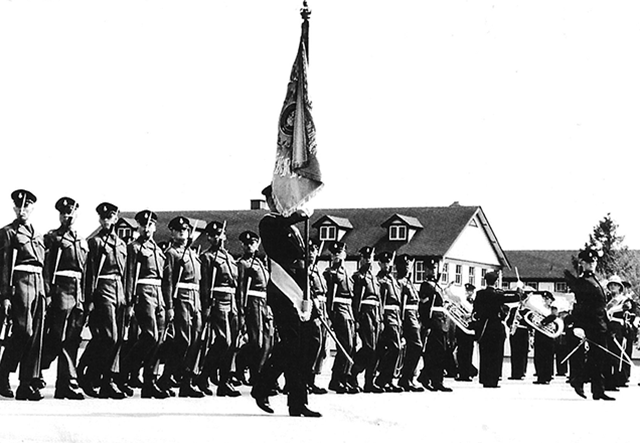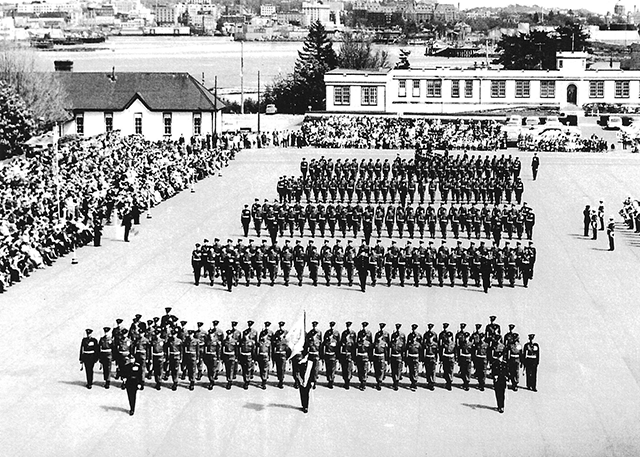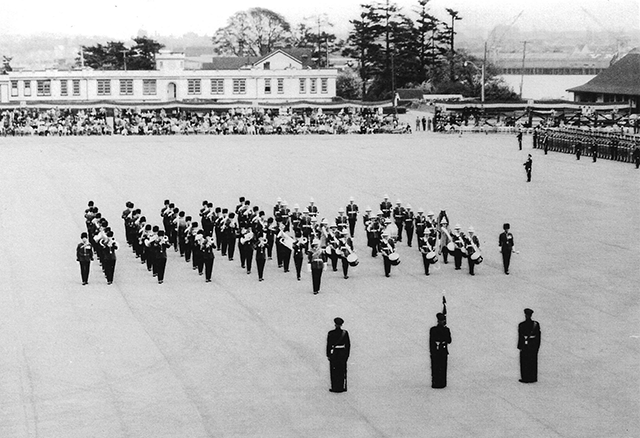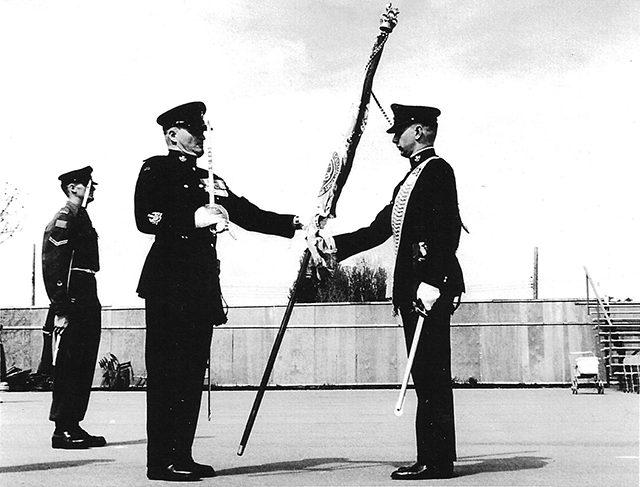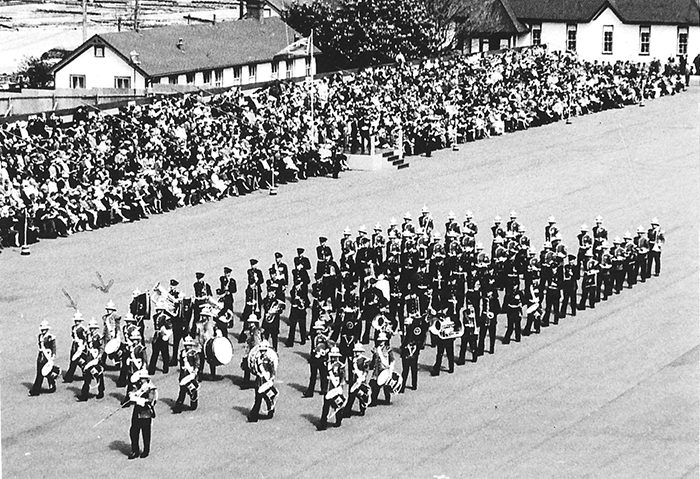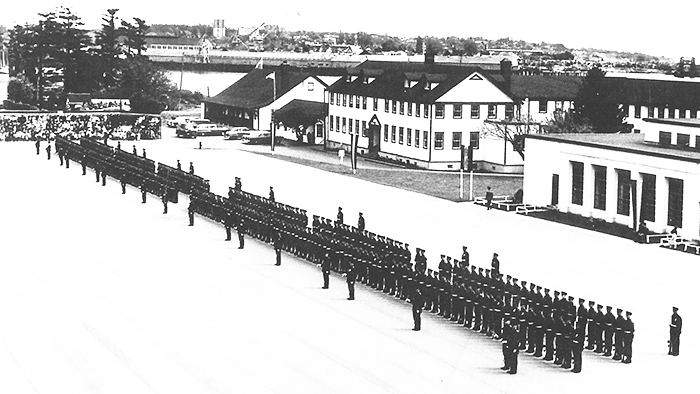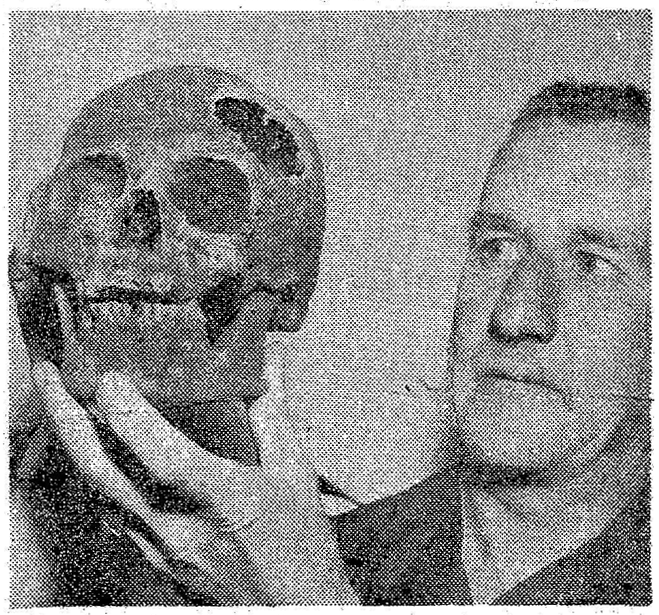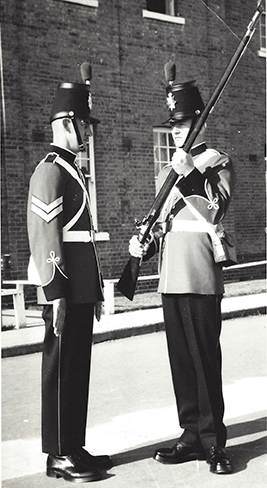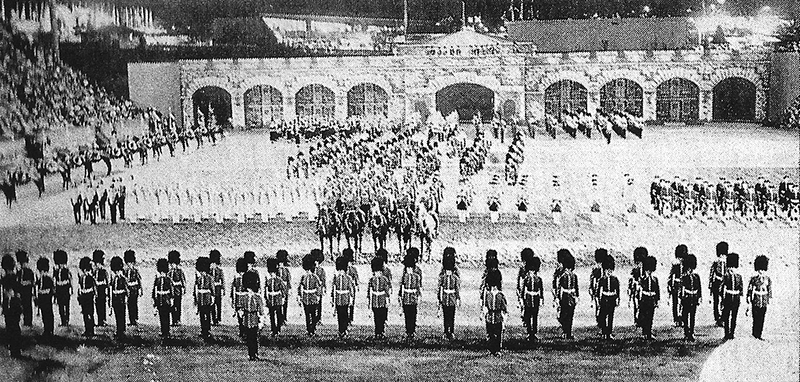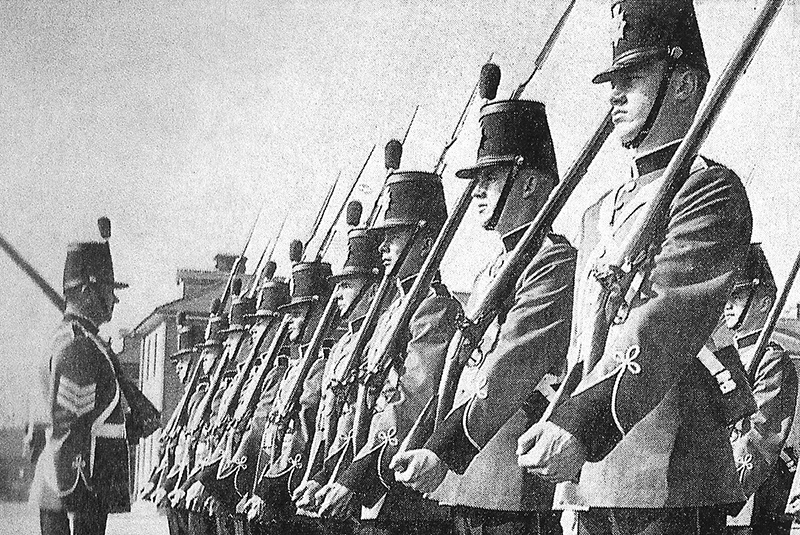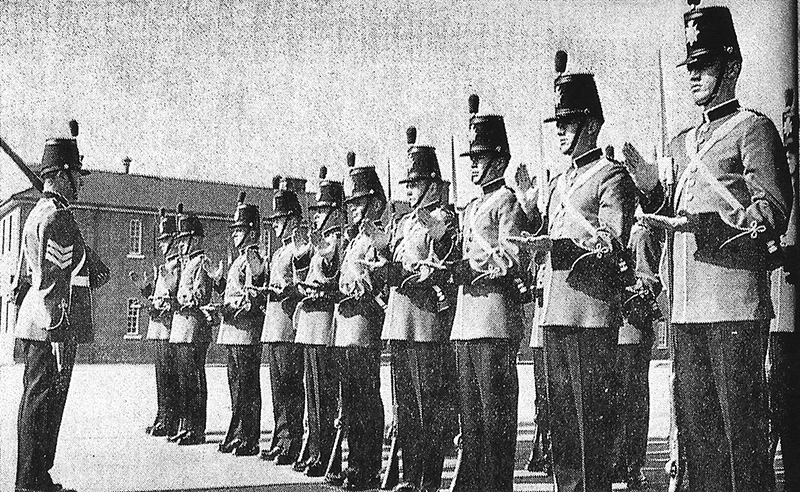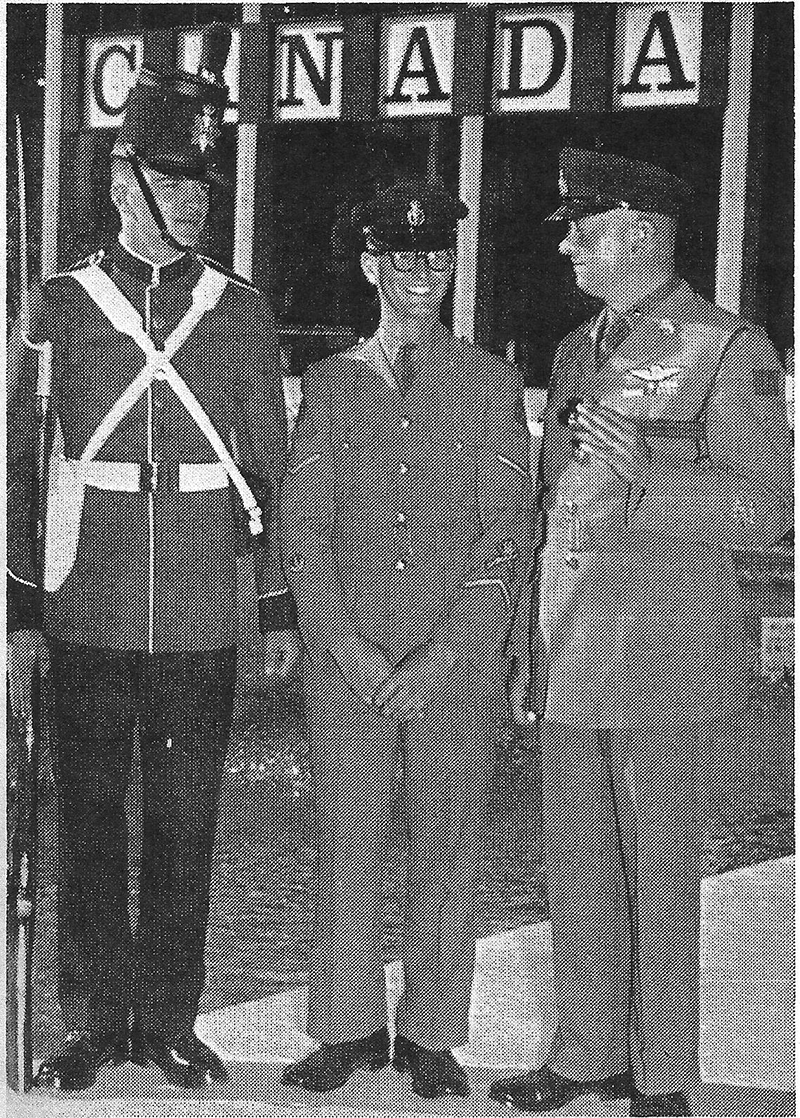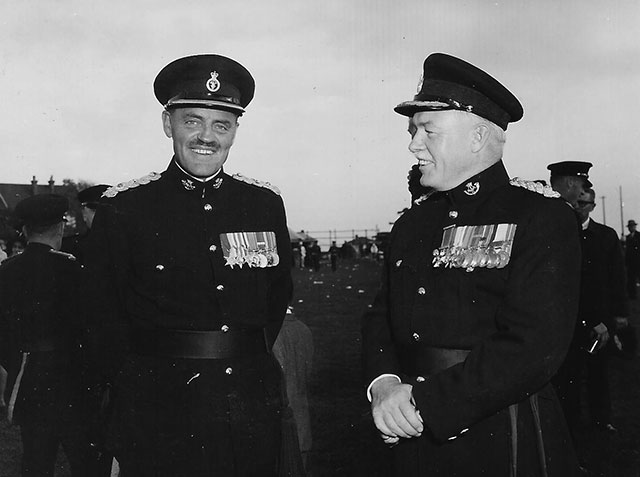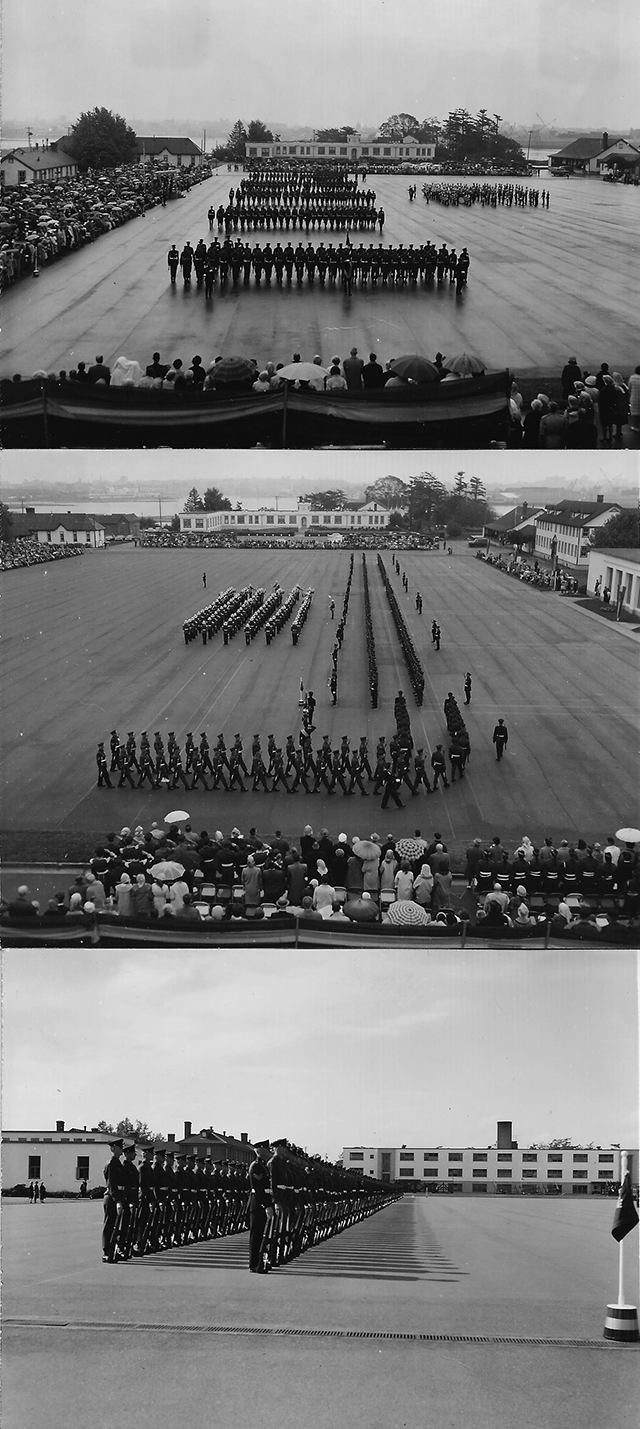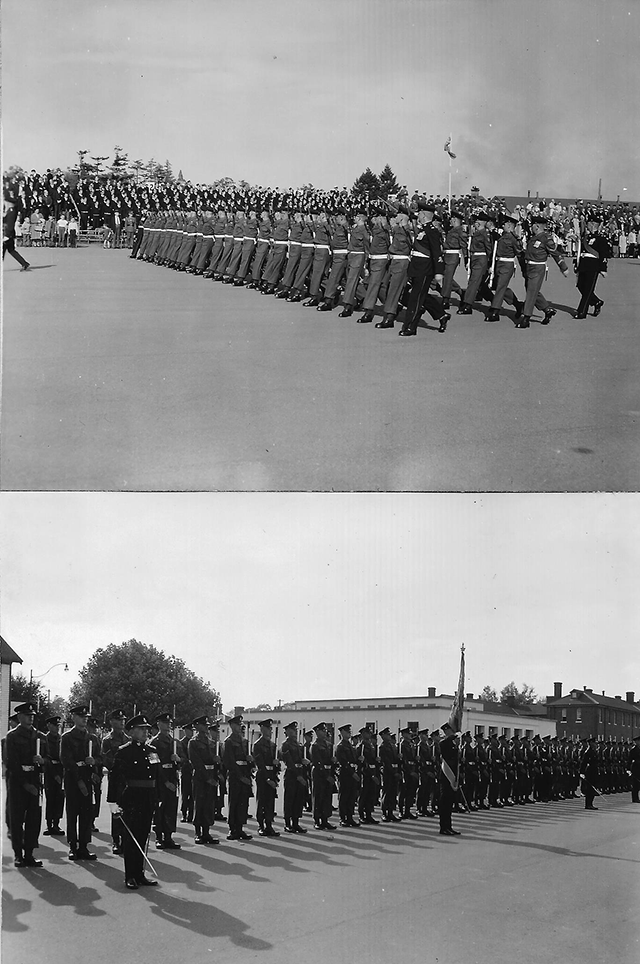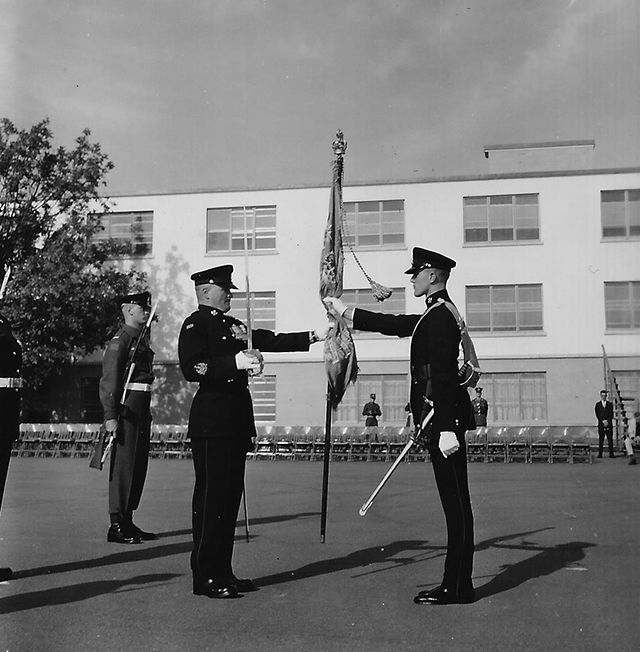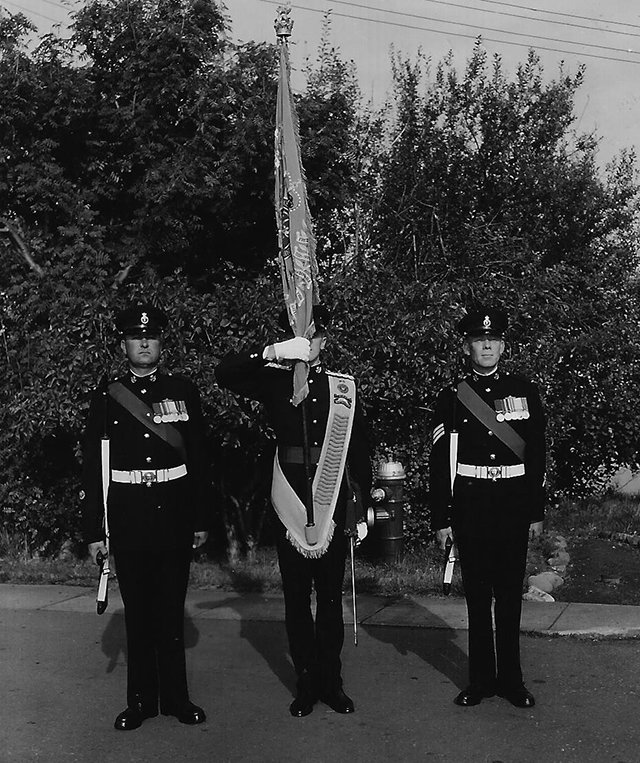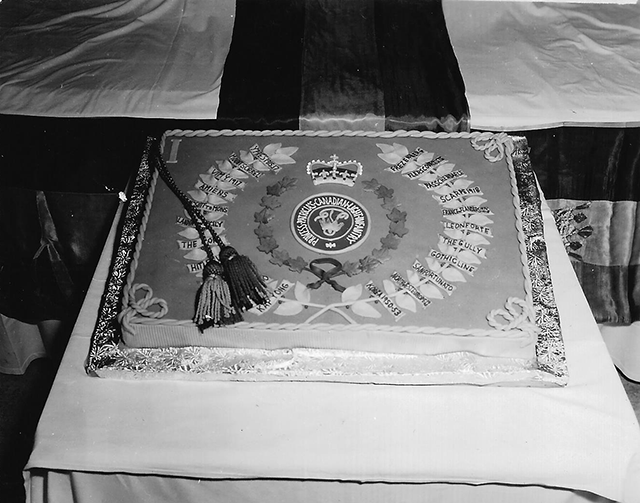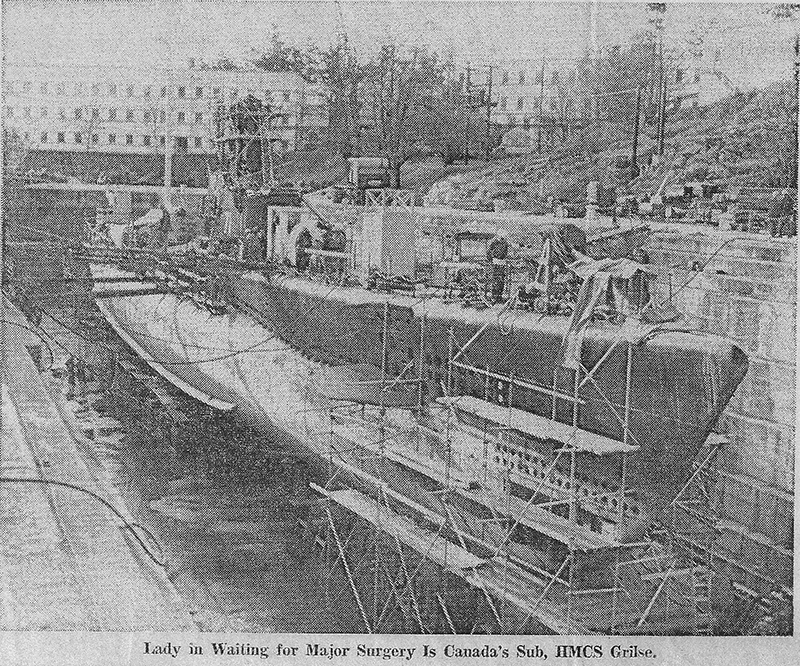 |
 OPCMHVisitor No.: |
HISTORY OF WORK POINT BARRACKSby Jack BatesPART 7 — 1957 to 196319574 LAA Battery was relocated to Picton, Ontario, and the 1st Artillery Maintenance Unit was disbanded. Building 1075 in Work Point, the brick barracks built for the Royal Garrison Artillery in 1902, and “Recognized” by FHBRO, has a bronze plaque embedded in the outside south wall next to the entrance. It is inscribed: CAVE BLOCK CONSTRUCTED BY RENOVATED BY
The Patrician Patricia’s Return To Work Point Barracks After a period of 18 years absence, during which the battalion has seen service in two wars, and a two year tour of duty in NATO, the Patricia’s returned to Work Point Barracks. The advance party, headed by Major C.V. Lilley, MC, CD, arrived on 4 November to find the nucleus of an advance party already on the spot. This group was under command of Capt. A.V. Stopps, who had gathered considerable information about the area, which proved invaluable to the advance party. The two main problems to be solved were, first, to fit the battalion into Work Point Barracks, which were not designed to accommodate a battalion. The second was to take over Barrack Stores from HQ Esquimalt Garrison, and then to move all the stores and equipment received from the 2 QOR of C from Gordon Head to Work Point. Foresight on the part of Lt. Col. J.C. Cave, CD, Commandant of Esquimalt Garrison, in having renovation of the old barrack block begun prior to the arrival of the advance party, avoided a difficult situation in barrack room space. Lt. Col. Cave recalled to us the days when he was quartered in the same building while serving with B Company before WW II. History has a habit or repeating itself, as B Company is once again quartered in this barracks block. The other problems of accommodation were soon solved. The trick now is to marry off enough of the new soldiers coming into the battalion so that we won’t run short of bed space in the barracks. Weapons and equipment are now becoming available, thanks to a big job well done by the QM Staff. Seventy five of our married personnel have been able to get PMQ’s. Very little difficulty is being experienced in obtaining suitable private accommodation for the others. The people of the island have given us a warm welcome home, and are not taking advantage of the sudden demand for housing. Accommodation comparable to PMQ’s can be had for between Ninety and One Hundred dollars a month. The two main training areas, Mary Hill and Albert Head, are fifteen and ten miles respectively from camp, just a good march distance. Work Point boasts and excellent 30-yard range. To augment this there are ranges at Heal’s and Nanaimo. Approval has been given for the construction of a parade square large enough to Troop on, and a new sports field which will include a 440-yard cinder track. The use of the gym and swimming pool at Naden once a week for each company, and recreational training such as golf and fishing the year round, should make this a paradise indeed. Shortly after the arrival of the advance party the officers were invited to a cocktail party by Major (Paddy) Crofton at his home, where they were able to visit with Brig. Colquhoun before his departure for Europe. 1958The Patrician Sergeant’s Mess After a great deal of bartering, buying and horse trading, the large blue sign “RCA SGT’S & WO’s Mess” sign was quietly removed from its anchorage on 1st Dec 1957 and the Patricia’s officially took over at Work Point Barracks. 1PPCLI The Ceremony of Work Point Barracks, Esquimalt, B.C. HSMBC Fort Rodd Hill Historic Sites Designation Proceedings Click here to view Proceedings as a PDF file. MAJOR WALTER BAPTY 2 CMR Click here to view the memoirs of Major Walter Bapty as a PDF file. There is also a book published in 2003 on the history of the 2 CMR, by CEF BOOKS in Ottawa, titled “THE 2ND CANADIAN MOUNTED RIFLES [British Columbia Horse] IN FRANCE AND FLANDERS 1914-1919.” TIMES WAR THREATS, CENSORS, BLACKOUTS KNOWN HERE The scorching breath of war swished the face of British Columbia several times during the last 100 years. Vancouver Island, in particular, was in the forefront of the troubles, as it had been 175 years previously when the British and Spaniards made faces at each other in the Nootka area. After the Japanese had made a mess of the United States Navy at Pearl Harbor on December 7, 1941, the extent of the menace which threatened this coast was disturbing. When the japs invaded Kiska and Attu in the Aleutian Islands and began bombing Dutch Harbor in Alaska, the people on this coastline learned to live like moles. Some of them built concrete air-raid shelters, everyone was fitted with gas masks and emergency supplies of food were cached. All street lights were turned off for the duration, car headlights were reduced to mere slits, houses and buildings were blacked out.
There were many scares, the worst, when unidentified planes were reported. The sirens whined, ARP wardens and their staffs manned their posts. Householders got out their buckets of sand, tested their stirrup pumps, made ready with flashlights and candles, in case of power failure, and checked members of the family. They wondered if bombs would fall. Under such trying conditions the “all clear” signal brought comforting relief. JAP SUBS PEEKING AT VICTORIA Then, came the torpedoing of a United States freighter just west of Race Rocks, a scant 30 miles from Victoria’s front door. The question arose: “Was it safe to cross to Vancouver by boat?” Japanese submarines were believed to be peeking at Victoria’s waterfront. The passenger ships running to the mainland steamed without lights at night. Their pilot houses were heavily timbered and padded as a protection against shelling. On a quiet night summer’s evening in June, 1942, two Jap submarines surfaced off Estevan Point, 150 miles northwest of Victoria, and opened fire. The few residents there were startled as shells dropped around them. The Jap fire was erratic and failed to hit either the big lighthouse or the wireless station. Other ships were torpedoed off the coast. “The Japanese are virtually upon the coast of Canada,” J.G. Turgeon, MP for the Cariboo, told a hushed House of Commons in Ottawa. Tokyo broadcast: “The shelling of Estevan has come as a great shock to Canada.” Unannounced, a corps of censors had moved on to Vancouver Island. Each outgoing piece of mail was censored, some of it heavily marked, some of it cut out with scissors, because too many people who had speaking acquaintance with army personnel, were unintentionally sending out tips, enough of which, put together, might have revealed what was going on. A few months later, what had been taking place, became public knowledge. A Canadian expeditionary Force was being assembled to aid the Americans drive the Japs from Kiska and liberate the North Coast from the threat of invasion. The Canadians went into training at Nanaimo and Chemainus under the operation name of “Greenlight.” On July 12, the Canadians, 4,831 strong, embarked on four transports. There was some grumbling among the men and 165 were absent without leave. Zero hour for landing on Kiska was daybreak August 15. When the boys stormed the beaches the island wad found deserted. The Japs had left 18 days earlier. One of the big moments and, the only occasion on which enemy seamen were handled through Esquimalt, was in 1940 when HMCS Prince Robert brought in the German express freighter Weser, which she has surprised and captured off the Mexican Coast. Going back to the First World War Victoria spent the first three months of it wondering if shells would be rained from the German fleet which had escaped from the Tsingtao base in China. The fleet slipped across the north Pacific and skirted the B.C. Coast, which had only an obsolete cruiser, the Rainbow, to offer resistance. To Rainbow’s credit stands the fact that she went forth to wage battle. Flipping back the pages of time to 1877 there appears another phase of apprehension. Russia was the offender. It had sold Alaska to the United States ten years previously but was still eyeing the Pacific Coast. Britain and Russia were at loggerheads over a middle east question and the Pacific Coast had reason to suspect the intent of a Russian fleet which appeared in these waters.
These fears became a reality when a Russian gunboat appeared off Race Rocks and heading straight for Esquimalt Harbor. The alarm was sounded but the gunboat, the Craysser, was an innocent party to any disturbance. She had experienced heavy weather, suffered some damage and was in need of fresh water and provisions. Leaping backwards another 20 years war scare was on the horizon as British Columbia was born. The rumpus was caused when a United States farmer shot a Hudson’s Bay Company’s pig on San Juan Island. It was at the time when the Americans held one end of the island and the British held the other. Each had their forts. Historians refer to this as the “pig scare.” It may cause a laugh today but it was a serious affair in 1859. The first representatives of the Royal Navy to enter Esquimalt Harbor arrived on a hunting and fishing expedition. None of the warships passed through the headlands as no soundings had been taken and the great Douglas firs came down to the water-edge. As time passed, the navy set up shore batteries at Duntze Head and Rod Hill to protect the entrance to Esquimalt Harbor. When Britain realized the growing importance of British Columbia, units of the Royal Artillery and Royal Engineers were sent out and new forts were built at Macaulay Point. Work Point barracks was established. In 1871 announcement was made of creation of Military District 11, which included all British Columbia and had its headquarters at Work Point. With opening of the 20th Century the Royal Navy has a strong fleet here and the shore fortifications included a pair of 9.2 guns, mounted atop Signal Hill, capable of flinging a 500 pound shell out to Race Rocks. Germany’s rapid development of sea power was viewed with alarm by the Admiralty and the decision was made to withdraw overseas fleets and concentrate at home. The Canadian government’s attitude of aloofness from sharing in the cost of protecting its own shores, was also a factor in the decision. In 1905 the Royal Navy withdrew. Canada slumbered along until 1910 when it embarked on a half-baked naval policy. One of two ships, the Rainbow, was sent here. The forts were the playthings of the militia. Lord Jellico visited Esquimalt in 1919 on his world cruise aboard HMS New Zealand. He made a survey of what the Empire needed in the way of a naval program. After Jellico’s report Canada began getting destroyers and specializing in anti-submarine work. When the Second World War broke out there were some fighting ships at Esquimalt. The ports of Esquimalt and Victoria, were ringed by a stout series of forts, ranging from the three 9.2 battery at Albert Head down to the rapid-firers close in. Today, there is not a gun on the entire British Columbia coast. They have been removed as, under today’s tactics, they would be useless. Defence of the coastline depends upon the Royal Canadian navy and the Royal Canadian Air Force. Esquimalt is a base of large proportions. Its ships have personnel of over 6,000 officers and men. Its shore personnel of civilians is over 3,400. July 15, 1958 “The Glass House”, a local name for the Work Point Detention Barracks, was closed on this date. It was called No. 15 Service Detention Barracks at the time.
COLONIST PRINCESS SOPHIA SINKS The Patrician OFFICER’S MESS Swimming in the mess pool became popular in June 1958. The pool was cleaned out with the help of some “volunteers” from the RCN who were enjoying army hospitality in our “crowbar hotel” and was soon ready for use after the long period of neglect. TROOPING The ceremony of “Trooping the Colour” carried out by the First Battalion at Work Point Barracks on 31 May is believed to have been the first such ceremony ever carried out by a regular force unit in this part of Canada. Together with its accompanying social functions, the ceremony was a great success, and was enjoyed by all who attended. The weather on the morning of 31 May threatened rain, but fortunately the sky cleared a little as the day wore on. Some 3500 invited guests and about 1500 additional members of the general public turned out to watch the Battalion Troop its Colour. ENGLISH RUGBY Some old Patricia’s may remember the Rugger Team of 1934-39 which became BC Champions. When we heard of this we decided to give it a try ourselves. Undaunted by the fact that only three persons in the battalion had played before, we began practicing twice a week. After a few instructional periods, games were played with following results:
VICTORIA On 10 January ’58 the former 4 LAA Bty Cadet Corps of Victoria was taken into the PPCLI family. 2Lt PM Stevens acted as liaison between the battalion and the cadet corps, later relinquishing the job to Lt JD Snowball. Lt Col de Faye officially welcomed the corps into the PPCLI family and presented each cadet with a new PPCLI cap badge. Training during the winter and spring was conducted on Tuesdays and Fridays at the Macaulay drill hall. In addition to this the corps participated in 15 small-bore rifle competitions throughout the winter season. There were 5 first class shots in DCRA, Sgt Walder having a total of 295 points, and Cpl Barclay 294. Silver spoons were presented each week to the best shot and each winner earned 3 points for the following week’s shot. This encouraged the poorer shots to increase their scores in order to win. The band under Cdt Sgt Cuzner and Cdt LCpl Bennallack progressed very well. The following promotions were awarded:
The annual inspection was held on 30 April with 51 cadets on parade. This was attended by numerous parents and other spectators. Lt Col de Faye was the inspecting officer, and British Columbia Area was represented by Capt RH Graham and Lt D Walton. 15 cadets enjoyed summer training at Vernon. ROYAL CANADIAN CORPS OF SIGNALS
Click here to zoom in with a PDF file 1959Daily Colonist FIRST EXPLORERS ... Estevan Point again made history when, on June 20, 1942, a Japanese submarine surfaced about half a mile off shore and shelled the light house. Approximately 25 shells were fired, and except for a few buildings hit by shell fragments, no damage was caused either to the lighthouse or radio station. The shells were 5.9 calibre and weighed 80 pounds; a dud found on the beach was weighed. Several overshot the target and landed in the vicinity of the Hesquiat Indian village, five miles directly behind the light house. They scared the Indians but did no damage. COLONIST F. V. LONGSTAFF Tells How In Old-Time Victoria NAVY MADE THE HOLIDAY In 1942 I began searching the files of the Daily Colonist to discover what took place in naval and military commands on May 24 each year. I have come to the conclusion that the form of celebration each year depended on the wishes of the Admiral at Esquimalt and later on the officer commanding the permanent Imperial or Canadian troops at Work Point Barracks. (For the details of the Rear Admirals and Officers Commanding troops at Work Point see my “History of Esquimalt and its Base” published in 1942.)
Beacon Hill was the favorite drill ground for the sailors and marines. The first idea that naval officers had to celebrate May 24 was holding a regatta for service crews and boats in the naval harbor and at the same time throwing the naval ships open to the public. Officers invited to the wardroom families who had entertained them in their own homes. It appears that the first regatta in the Gorge, when boats from the naval ships competed, was in May 1867, when Commander T.E. Smith, RN, of the screw sloop of war Shearwater was active in the work. In 1870 the Flying Squadron was in Esquimalt Harbor from may 15 to 28. On May 20 a naval review and regatta was held under Rear Admirals Arthur Farquhar and Geoffrey Thomas Phipps, Hornby. The ships were also thrown open to the public. Seventy-one years ago, July 27, 1883, Rear Admiral Sir Algernon McLennan Lyons, GCB, flying his flag in the fine iron steam frigate Swiftsure (ship rigged) ordered the armed parties to land from the squadron, the Mutine and Sappho, and drill on Beacon Hill. The naval brigade came to the inner harbor in eight pulling boats in tow of two steam picket boats and a steam pinnace. The men and guns disembarked near the match factory, the number being 25 officers, 215 bluejackets, 125 marines, 69 bluejackets with three field guns and two machine guns and five buglers, a total of 440. The band of the flagship played the brigade along the streets, the battalions were put through the manual, firing exercises, forming square with the guns in position. Then came skirmishing order, when the marines reinforced and the exercise closed with all the troops charging and cheering. The commander in chief himself was the inspecting officer, hence it is probable that the landing exercise had been seldom carried out. The brigade was under Commander Frederick Edwards of the sloop Mutine. There is no mention of the Lieutenant Governor being present, and thus it appears that the Admiral simply wanted to inspect his brigade in drill. The next mention was in 1885, on May 25, when a mine was exploded under a hulk in Esquimalt Harbor. In the afternoon the regatta in the Gorge was entered by three whalers, also cutters, galleys and a launch. In 1886, on May 24, a sham fight was carried out on Macaulay plain, when the bluejackets and marines arrived about 9 a.m. and a few minutes later were put through the drills. Many spectators were present. In 1888 the regatta in the Gorge was patronized by entries from the ships in Esquimalt, the Caroline and Wild Swan. In 1889 the regatta was held in the Gorge on May 25, a sham fight was held on Beacon Hill. Steam cutters from the Swiftsure, Icarus and Amphion towed launches and cutters carrying 600 officers and ratings, under Flag Captain J. L. Hammit. The defenders were “C Battery “of the Royal Canadian Artillery under Major James Peters, with officers and men of the Fifth Regiment under Lieut. Colonel E. G. Prior. In 1891 naval crews from the ships of war entered the regatta in the Gorge. In 1891 naval crews from the ships of war entered the regatta in the Gorge. In 1892, naval crews entered the races at the Gorge. On May 27 a sham fight was held on Beacon Hill, by the bluejackets, the marines and the artillery from Work Point and the Fifth Regiment. In 1893 on May 25 naval crews entered the races in the Gorge, but no sham fight was held. In 1895 on May 25 naval crews entered for the races under the patronage of Rear Admiral H. F. Stephenson, and crews from the Royal Arthur, flagship, and the Hyacinth and the Royal Marine Artillery paraded at Work Point, and the band of the Fifth Regiment. On May 27, a sham fight took place on Beacon Hill, the forces a battalion of sailors, a battery of Royal marine Artillery and the drum and fife band from the barracks and RMLI from the ships. Both the Lieutenant Governor, the Honorable Edgar Dewdney (for the first time) and the Admiral were present. In 1896, on May 27 a review was held on Macaulay plain with the RMA from the barracks with 18 pounder gun, RMLI from the ships, sailors with nine pounder guns, the Fifth Regiment. During the review news of the Point Ellice bridge disaster arrived and some of the senior officers set off on horseback at once to the scene. The review was stopped and the troops marched home. May 25, 1897, was a quiet holiday, with no royal salute. All the ships of war were away, the Imperieuse being at Comox for gunnery, while the Comus and Pheasant were at Departure Bay. May 24, 1898, saw naval crews entering for races up the gorge as usual. On May 25 the Fifth Regiment under Lieutenant Colonel E. G. Prior, and the Second Battalion under Lieutenant Colonel C. A. Worsnop from Vancouver, and the naval battalion under Captain Frank Finnis, RN, the Royal Marine Light Infantry from the ships and the Royal Marine Artillery from the barracks, with nine pounder gun with a bluejacket crew, took part in the great review. On May 25, 1899, no review was held, but there was a rifle competition at Clover Point range. The men of the Royal Marine Artillery and Light Infantry competed individually. The naval vessels in Esquimalt Harbor were visited by about 1,500 people. In 1901, May 24, naval boats crews competed in the Gorge regatta. A review was held on Macaulay plain. Battalions of seamen, marines and artillery were present under the command of the Flag Captain T. P. Walker, RN. The commander in chief was Rear Admiral Andrew Kennedy Bickford. May 24, 1903, naval crews competed in the Gorge regatta and the vessels in Esquimalt harbor were open to visitors, and again in 1904, naval crews competed at the Gorge. This was the last time of any record of ships of the Pacific Station taking part in the regatta. For the closing of the station see my history of Esquimalt, published 1942. — F. V. Longstaff 1PPCLI FIRST BATTALION PRINCESS PATRICIA’S CANADIAN LIGHT INFANTRY The Ceremony of Beacon Hill Park COLONIST INCREDIBLE MASS OF 20,000 SEES MEMORABLE COLOR RITE We Were All Soldiers of the Queen Yesterday All of us in the incredible mass of 20,000 stood to attention in the sun-baked Amphitheatre called Beacon Hill Park each time she rose. Three times we sang “God Save the Queen.” The troops, those magnificent soldiers of the Princess Patricia’s Canadian Light Infantry, stood altogether 90 minutes to attention, six minutes to ease. No one will forget the sight they made, marching on the square before her Majesty’s arrival, the color escort guard first, then five more guards, each of 54 men and three officers. EARTH SHOOK The earth literally shook each time 360 pairs of feet came to a halt. The Queen’s arrival caused a roar from the crowd, as immediately on her arrival, she stepped into a grey Land Rover and reviewed her guards, sun-bleached into thin golden lines. Such pageantry may never be seen in Victoria again. This is the first time in British Columbia at least that a reigning monarch has presented colors. REGAL IN BLUE Elizabeth II was regal in vivid royal blue and pink organdy hat, when she gave the color to the PPCLI and the guidon to the King’s Own Calgary Regiment. Three times yesterday the new colors were dipped to the young monarch. Those who saw the presentation may never again see the colors dipped, for they are dipped only to the sovereign. BLADE – STRAIGHT When the guards came past in slow time their lines as straight as the edge of a blade, Prince Phillip smiled with appreciation. Several times he turned to Defence Minister Pearkes on the dias slightly to the rear, with pleased comment. Col. J.C. Allen, commanding officer of the regiment, didn’t see her, but the Queen gave him a long look of appreciation as if to say, “Well done.” UNFORGETTABLE The soldiers put on an unforgettable show, from the ram-rod straight RSM J.G. Austin, who holds the Military Cross, to that splendid man, Drum Major W.E. Wymas, who threw his silver baton and caught it with authority. When the six guards broke from slow time to quick time on the march, applause rolled down the hill, and when the band played “Tipperary” there were many a misty eye. EXACT MOMENT At the exact moment of the advance, an arrow of bombers from 407 and 408 Squadrons, RCAF Comox, flew past. Then came the “E” for Elizabeth, spelled by CF-100 jets. The Queen looked up and smiled. There was something medieval about the presentation ceremony itself, and a bond as old as history between the Queen and the Queen’s men could be felt. There were three subalterns at her feet, three chaplains standing by with bowed heads, the flags draped over a pyramid of drums and her guards around her in a hollow square. “The battle honors which are emblazoned on your new colors commemorate this service and will remind you of the the spirit of loyalty and devotion which have marked your famous regiments” said the Queen. “They will keep before you the memory and example of your gallant deed.”
COLONIST NO “INCIDENTS” — BUT THERE WAS ONE PPCLI press liaison officer, Lieut. Peter Stevens boasted yesterday. “There are no incidents with the Patricia’s.” But an “incident” did happen — a member of the color escort collapsed from the heat during the early minutes of the ceremony. He was carried into the shade, quickly recovered and resumed his place. *** There were 1,700 officially invited guests at the color ceremony, but the unofficially invited guests — the general public — far outnumbered them. Beacon Hill was half covered with people 30 minutes before Queen Elizabeth and Prince Phillip arrived at the parade square. It was completely covered. *** Queen Elizabeth’s unscheduled review of the guards at the color ceremony was made in a civilian Land Rover borrowed for the occasion. The PPCLI was tipped off from Vancouver that Her Majesty might wish to review the troops, and it was suggested that an English made Land Rover would be more suitable than the army’s U.S. made Jeeps. Tuesday morning they borrowed the new vehicle from Jamieson Motors, built a platform in the rear with steps up to it, and installed a brass bar for the Queen to hold. *** The 450 soldiers who represented the PPCLI in the color ceremony had only three weeks of fairly intensive training in the procedure. Apart from supervised drill periods, many of them spent part of their own time practicing marching. The Queen followed the whole of the color ceremony from a copy of the printed program, referring to it constantly until the time came for her to take an active part. Then she put the program down and carried out her duties confidently. *** The naturalness of Queen Elizabeth delighted spectators. When her nose itched, she scratched it. A short time later she “primped,” adjusting her hat. More or less the forgotten man at the color ceremony was Prince Phillip. More so less at any time on Vancouver Island, the husband became merely a loyal subject. For more on this memorable event click here to view an account from THE PATRICIAN 1959-1960. 1 PPCLI
Times OLD COLORS NEVER DIE Ceremony rich in tradition saw old colors of 1st Battalion, PPCLI, deposited for safe keeping at St. Paul’s Church, Esquimalt, today. Color party, seen entering church, laid up old colors after receiving new ones from Queen Elizabeth last summer.
Times “SAFEKEEPING” Old PPCLI Colours Rest At The Altar In a ceremony both colourful and solemn the old colours of the 1st battalion, PPCLI, were placed in permanent safekeeping at St. Paul’s Naval and Garrison church, Esquimalt this morning. The colours had been in the battalion’s possession since 1934, when they were presented by the earl of Bessborough, then Governor General of Canada. They were replaced this summer when Queen Elizabeth presented new colours at Beacon Hill Park. Regimental colours, by ancient tradition and by a regulation which came into effect in 1898, are deposited in churches for safekeeping when not in use, or as a permanent record when they have been retired from active use. The colour guard today was escorted by an honour guard with fixed bayonets from Work Point, marching along Head street to Esquimalt road, then to the church. The honour guard was preceeded by the scarlet-jacketed, white-helmeted battalion band. THREE TIMES The ceremony at the church began when Capt. Robert Frost, adjutant, pounded three times on the closed doors with the hilt of his sword. The door was opened by Rev. J.S. Roberts, Rector of St. Paul’s, and Capt. Frost said: “Reverend sir, I have been commanded by Lt. Col. J.C. Allan, commanding officer of the 1st Battalion, Princess Patricia’s Canadian Light Infantry, to inform the authorities of this church that he has repaired here today with the old colours of the battalion and desires admission to prefer a request that they be deposited herein.” PRESENT ARMS The rector replied that “every facility will be afforded him in executing his most laudable purpose.” The honour guard then carried out the command “to the old colours, Present Arms,” and the colour party carried the colours into the church. Following divine service, the colours were turned over to the warden by Col. Allan. The rector received the colours from the warden, and draped them on the altar, where they were saluted by Col. Allan and the officers of the colour party. FORT MACAULAY A photograph taken by Kidd in 1959 at Fort Macaulay looking southerly at the Strait of Juan de Fuca through the Battery Command Post.
This photo taken in 1959 shows what the Macaulay Point / Fleming Beach / tidal water swimming pool looked like before the breakwater was built in 1965. Grant Keddie photo. According to a local resident who lives on Clifton Terrace the breakwater was widened in 1969. 1960The Patrician Laying Up of Old Colours For the First Battalion, 1959 will be remembered as the year Her Majesty the Queen presented New Colours to the Battalion. A less spectacular but equally moving ceremony took place on 25 November, when the Old Colours were laid up in t. Paul’s (Anglican) Church of Esquimalt. These Colours were presented to the Regiment on 14 April 1934 by the Earl Of Bessborough, Governor General of Canada, at a parade in Minto Street Armouries in Winnipeg. Thousands of Patricia’s served under the Colours in the 25 years they were in service. Of these, 14 officers and 203 other ranks gave their lives in action against the enemy in World War II or Korea. St. Paul’s was chosen for many reasons. The Regiment has an affiliation with the church dating from 1920 when B Company was stationed at Work Point Barracks. There are three plaques in the church commemorating the service of Patricia’s who died while serving in Victoria. In army circles the church is still known and fondly referred to as “The Garrison Church.” The Battalion was fortunate to have a sunny day on the 25th as it had been particularly wet the previous few days. When the Guards formed up on the square at Work Point, it was discernible that many on parade had served under the colours in Sicily, Italy, North West Europe or Korea. The Guard Commanders were Major WG Milne and Major AGW Harbord-Harbord and the Colour Officers Lt WJ Kitson for the Queen’s Colour and Lt RM MacIntosh for the Regimental Colour. The only serving Patricia to be on parade both on 14 April 1934 and 25 November 1959 was WO 2 FL Mack. Led by the Corps of Drums, the Colours were escorted through the streets of Esquimalt to St. Paul’s. At the church the Adjutant, Capt RJ Frost, sought entry for the Colours from Reverend JA Roberts, the Rector. Led by the Commanding Officer, Lt JC Allen, the procession entered the church and Lt Col Allan preferred a request that the Colours be deposited. After an acceptance by the Rector the Guard Commanders received the Colours from the Colour Officers and handed them to the Church Wardens. The Rector then laid the Colours on the altar and Divine Service followed. While the seating in the church was limited, some 90 Patricia’s and an equal number of dependents and guests formed the congregation. Among the distinguished guests were His Honor the Lieutenant Governor and Mrs Frank Ross, and former Commanding Officers Brig WG Colquhoun and Lt Col JN Edgar. Lt Col VR Schjelderup, Commanding Officer of 2nd Battalion came from Edmonton for the ceremony. Maj PD Crofton and twelve former Patricia’s attended from the Association including S/Sgt G McIllvenny who was on parade in 1934. After the divine service, informal receptions were held in the Officer’s and Sergeant’s messes. In the words of the Commanding Officer during the ceremony the Colours were laid up in St. Paul’s “to provide a memorial to the men of all ranks who served under these Colours, and to afford an inspiration for the patriotic service and sacrifice for all who may worship here for all time to come.”
1 PPCLI
2483 PPCLI Cadet Corps This is the program from the 1960 Annual Ceremonial Review held at Work Point Barracks where the Corps Flag was presented. This was during the time frame when the 1st Battalion was the resident garrison force stationed at Work Point. 1PPCLI FIRST BATTALION PRINCESS PATRICIA'S CANADIAN LIGHT INFANTRY The Ceremony of THE BATTLE OF FREZENBERG Reviewing Officer Work Point Barracks Friday, May 27, 1960 1 PPCLI - WO’s and Sr. NCO’s 1960 Run cursor over image to stop movement. Panning script compliments of Vic Phillips. 2483 PPCLI Cadet Corps
ESQUIMALT
COLONIST HIGH ADVENTURE An article by Agnes Carne Tate on old roadhouse in the area. December 4, 1960 (53, 55) COLE ISLAND KEPT THE NAVY’S POWDER DRY An article on COLE ISLAND by Ginnie Beardsley with photos. December 4, 1960 (58) WHEN THE 5TH INVADED SEATTLE An article by James C Nesbitt on the 5th Regiment. SIGNAL HILL Click to view aerial photo (PDF) taken between July 1959 and June 1962. HMCS Assiniboine, ship 234, arrived in 1959 and had a helicopter pad installed in June 1962, the Assiniboine doesn’t have it in the photo, per Base Museum’s Joseph Lenarcic. The two original 9.2 gun emplacements still had the building structures covers in tact from World War Two. 1961The Patrician TIME GUN In October and November the battalion was involved in one of the typical Victorian “tempest in a tea cup” which had as its centre, the time gun. This gun, from a practice originating many years prior to the war, is fired at 1200 and 2100 hours. The time gun is fired by a member of the Anti tank platoon of the battalion on a signal received from the Gonzales Observatory. Previously the only complaints received were when, due to some interruption in “phone” service or for some other reason, the gun was not fired. Then the Commanding Officer, the Adjutant and the Orderly Officer would be flooded with calls from various retired military gentlemen who wished to know what was wrong with the modern army. In the fall of the year, however, a new batch of ammunition was received for the time gun. This ammunition which was designed to better simulate artillery fire under field conditions contained a larger charge than the type used previously. In a few weeks there were many complaints in the local press and radio regarding the discomfort to local residents caused by the loud report of the new round. All ended well, however, as higher authority acted with commendable speed and took action to reduce the charge in the rounds provided for the time gun and those used for saluting purposes in Victoria. In the late 1930’s, when B Company PPCLI was the main resident Garrison unit, the telephone cable didn’t go all the way to the time gun shed. Beside the telephone in the Guardhouse there was a buzzer button, when pushed upon getting the timing from the Observatory, a bell would ring in the time gun shed and the duty Sergeant would then pull the lanyard to fire the gun. George Wilkinson knew exactly where the button was. According to records, the time gun shed, building # 1016, was built in 1906, rebuilt in 1946 and again in 1962, allegedly after a fire destroyed the second one. See November 2, 1888 for an origin of the Time Gun in Victoria. Times Neighbourhood Under Gun Every night at 9 o’clock, Ed Parlee of 240 Robert takes a firm grip on the arms of his chair, squeezes his eyes shut – and waits. The house grows still; so still that the clock rings like a blacksmith’s anvil. A sharp angry BOOM jolts the house. The windows rattle – and occasionally crack. The chair containing Mr.Parlee bucks like a wild thing. The cat runs squalling for the basement. As the sound subsides and the plaster sifts down on Mr. Parlee’s neck, he shakes his fist wrathfully in the direction of Work Point Barracks. The Parlees have just lived through another bombardment from the Army’s evening gun. A slow man to anger, Mr. Parlee has suffered his nightly dose of shell shock without a whimper. But when the windows began to crack and the foundations seemed in danger of sagging, he decided to return the fire and complain. STATE OF SIEGE — A few calls to the no-man’s land surrounding Mr. Parlee’s embattled dwelling indicated that the entire neighbourhood was living in a state of siege. “Can I hear the 9 o’clock gun?” roared one. “I can’t hear another thing for 20 minutes afterward! It scares my wife, it terrifies my dog, my daughter is a burned out veteran at three years of age.” “I’ll say I can hear that gun!” HORRIBLE BANG — “Picture yourself in my living room,” says Ray Hunt, who lives at 311 Maitland and squarely in the line of fire. “We’re all watching TV, see? Nine o’clock rolls around and all of a sudden there’d this horrible bang. “My four kids go right out of their chairs. My wife drops her cup of tea. One day, by golly, I’ll fire back!” A neighbourhood observer paints a word picture of the events which lead up to the nightly blast. HEAVY SILENCE — Just before zero hour, traffic on neighbourhood strees slows to a crawl. Children stop playing, look anxiously in the direction of the barracks and scuttle into the house. Dogs and cats stop doing whatever it is they do and stand, twitching nervously. A heavy silence descends. The look on everyones’s face is a permanent sign of Work Point battle fatigue. 1PPCLI FIRST BATTALION PRINCES PATRICIA’S CANADIAN LIGHT INFANTRY The Ceremony of THE BATTLE OF FREZENBERG Reviewing Officer WORK POINT BARRACKS, ESQUIMALT, B.C. Run cursor over image to stop movement. Panning script compliments of Vic Phillips. COLONIST THEY WERE THE FIRST The Negro Rifle Brigade Was Victoria's Pioneer Militia By George Nicholson The Victoria Pioneer Rifle Corps was the first volunteer military unit in what is now British Columbia. It might well have been called the "All Blacks" for its officers, non-commissioned officers and men were full-blooded Negroes, naturalised British subjects, emigrants from the United States. Known by most people as the "African Rifles", but nicknamed by others: "Sir James Douglas' Colored Regiment", the corps was organized in 1860 and officially sworn in by Judge Cameron at a ceremony held at Fort Victoria, July 4, 1861. It was disbanded four years later giving way to the newly-organized Victoria Rifle Volunteer Corps, composed wholly of whites. From the pages of The Colonist covering that period, we learn of the circumstances which surrounded the formation of this unique unit and the reaction of Victoria's white population. "Early Defences of BC Coast" by Lieutenant-Colonel F. A. Robertson, DSO, one-time commanding officer of the Fifth Regiment, Canadian Garrison Artillery, and a precis on the subject prepared by Major J. S. Matthews, Vancouver City archivist, provide additional information. Both papers can be seen at the Provincial Archives. "The American Civil War had not yet broken out, and the emancipation of the slaves was a burning political question. The colored folk in California were dissatisfied with the law", an expression which probably was a very mild description of the real situation and were leaving. "... Delegates from Negro communities met at San Francisico to discuss how best they could improve their hard lot. Some of them had heard that there was a British Colony on Vancouver Island, to the north. Others had heard of Australia, whither a number of them went. A committee of three was appointed to visit Fort Victoria, interview the government and enquire whether it would permit them to land and give them its protection. Governor Douglas extended them a cordial invitation to establish themselves on British soil, and as a result of the favorabie report of the committee, several hundred colored folk changed their place of abode. "Those who were not hampered with much worldly goods came up on the old steamers Brother Jonathan and Pacific, two of the pioneer Pacific Coast steamships. Others, with their livestock, farm implements and house furniture, came in sailing vessels. All were looked upon as an acquisition to the embryo colony. "Meanwhile, the citizens of the future capital city of British Columbia had organized a volunteer fire brigade .... The Negroes volunteered to join and do their part, but the white pioneer firemen would have none of it. Theirs was to be no piebald company. Racial disputes resulted, but none of a very serious character and on the whole they were free from malice, for the Negroes were good citizens. "Denied membership in the volunteer fire brigade on account of their color, the Negroes decided to form an organization of their own. Their aspirations ran high, for they wanted it to be of a military character, and so approached Governor Douglas for permission to raise a rifle corps. "The request was duly granted and the Negroes forthwith proceeded to recruit, and by refusing to have any white persons in their army, soon had revengeful satisfaction on the fire brigade. In no time a healthy looking company with three officers and 50 men took shape. It also had nine band instruments, but no one to teach the would-be bandsmen to play: so a white bandmaster was reluctantly hired. Clashes were frequent between the fire brigade and the black citizen army, but bruises were few. "Uniforms, blue with white facings, especially made in England, were supplied by the Hudson's Bay Company. Headdress was a shako and all wore white kid gloves and pipe-clayed trappings. The officers carried long swords and the men were armed with an assortment of rifles loaned by the Hudson's Bay Company. These were mostly old flintlocks, but some were more modern and fitted with sword bayonets. "A sergeant of Marines, detailed for the purpose from HMS Swiftsure, was their instructor. They drilled twice a week in a hall, (afterwards used as a roller skating rink), on View Street, and sometimes on their parade ground, a common of about ten acres on Church Hill." In the provincial archives there is preserved a copy of a Militia return signed by Governor Douglas, dated August 1, 1862 in which the following information is given: "Victoria Pioneer Rifle Corps. Date of formation April 1860. Number of officers and men, captain, 1; lieutenant, 1; sergeant, 1; privates, 40. Average number of days in each year in which they were called out for training: drilled twice a week. Remarks: This Corps is composed wholly of colored persons, most of them naturalized British subjects, emigrants from the United States." Further extracts from old Colonist files are of interest. Sept. 20, 1861. "African Rifles. This Corps will proceed to Beacon Hill this afternoon, about 4 o'clock, for drill. Not having received their rifles, they will not engage in target practice .... As it is the first Volunteer Rifle Company ever formed here it will doubtless attract considerable attention. The company will be drilled by Sergt. Wade, HMS Bacchante." Oct. 9, 1861. "African Rifles. This Corps repatriated to Beacon Hill yesterday afternoon to the sound of "fife and drum." A drill sergeant from one of the men-of-war put them through on the glacis in very good style. Quite a number of rounds of blank cartridges were fired to resist an imaginary rivalry attack. January 9, 1862. "Pioneer Rifles. This company (colored) elected the following officers for the ensuing year on Tuesday evening. Captain W. Brown; 1st Lieut. R. H. Johnson. 2nd Lieut, J B Johnson; sergeant, R. Caesar; corporal, S. A. Steven; paymaster. F. A Booth; secretary, A. C. Richards. After the election was over, Lieut. Johnson gave a grand spread and the colored ladies presented $100 to the company." Quoting further from The Colonist: March 14, 1864: The Corps, with its brass band, paraded yesterday in downtown Victoria. The unit was drawn up in two ranks in an area adjoining the drill hall, when Sarah Pointer came forward and after laying the handsomely embroidered color across the drums, read the following address: "Captain and Members of the Victoria Pioneer Rifle Company: In behalf of the ladies of Victoria, I present you with this flag 'Union Jack'. It affords me much pleasure to do so as we know your loyalty to this government is proverbial. The fostering care it has shown to the oppressed ones of our race leaves us under many obligations to the sagacity and wisdom of her statesmen .... True you have not as yet been called on to rally under this flag for protection, yet the war of complexional distinction is upon us . . . . But men, as long as this flag shall wave over you, you may rest assured that no man, or set of men, can successfully grind you down under the hell of oppression. Then, soldiers, look up to this insignia of liberty, that has waved 1,000 years over the battle and the breeze. "Tn committing this color to your charge, we only hope that you will guard it well, and yourselves be untarnished as to color. It will inspire you in the hour of peril. It is a nation's proudest boast; it's a terror to a foe, and a canopy of peace to a freeman". Captain Johnson, sinking on one knee, received the flag. The arrival of Governor Kennedy, March 25, 1864 brought the grand career of the "Black Brigade" to a cold and cruel end. The Negroes wished to form an escort or guard of honor for the new governor upon his arrival to take office, but the white citizens of Victoria by no means fell in with the idea, and those in charge of arrangements finally banned the proposed honor guard. Not to be outdone, the Negroes with mixed feelings of good and ill humor, duly paraded at the drill hall on the day of the governor’s arrival, but instead of honoring the Queen's representative by forming a dark pageant around him to escort him to his new home, repaired to a restaurant kept by one of their own color on Beacon Hill, where they did honor to themselves by consuming dozens of fried chickens and lashings of beer. A few days later, on March 30, 1864, the Victoria Pioneer Rifle Corps paraded in full strength to the old government buildings, across James Bay, to pay its respects to the new Governor. The band played and Governor Kennedy reviewed the company, and afterwards addressed them. He regretted, he said, that he was compelled to refuse to give them official recognition, as there was no authority for their existence now that the Hudson's Bay Company's administrative powers were at an end. "I cannot recognize you. I would advise you to disband. You are liable ...." Here His Excellency refrained from passing further remarks "for it would do little good and merely offend a body of peaceful and loyal citizens." The officers saluted and the company was marched back across the old bridge to the drill hall. That afternoon the men gave up their arms to the Hudson's Bay Company and the Victoria Pioneer Rifle Corps passed out of existence — and almost out of memory. Click to view image of the Negro Rifle Brigade. Click to view The BC Black History Awareness Society website. Colonist TIME-TELLING GUN ENOUGH TO BLAST A TANK
LESS BANG AT 9 ARMY ASSURES UNHAPPY PUBLIC Firing of a gun at Work Point at noon and 9 p.m. has become such a routine procedure that military and civil officials no longer know how or when the custom originated. City officials have plenty of information about another familiar sound in this area, the 9:30 p.m. curfew whistle at the brewery. But this too has its complications – police say they can’t enforce the curfew by law. PLASTER LOOSE Attention was drawn to the 9 o’clock gun recently by a number of local residents who complained the daily blast jars plaster loose in their homes, breaks windows and frightens women, children and household pets. Army officials said yesterday they will investigate the possibility of reducing the noise and “ensure that any adverse effects in the civilian populace are minimized.” They were at a loss, along with civic officials, as to when the twice – daily custom started and whether it has any significance beyond obvious time signals at noon and 9 p.m. “The exact history of this ritual is not known by serving members of the Esquimalt garrison,” said an army spokesman, who added “a similar time gun is fired by the army at Halifax.” ROYAL ENGINEERS Another army spokesman said it may date back to the days when the Royal Engineers were stationed here. In post war years a Second World War anti-tank was used for the daily signals until little more than a year ago when it was hauled away and replaced by a 105 millimetre field artillery piece. NEED NO MORE Chief Constable John Blackstock said he would need 50 more men to enforce the current by-law. The curfew by-law, passed in 1943 and suspended by a similar by-law in 1959, requires that children under 16 be off the streets by 9:30 p.m. DAILY WARNING The downtown brewery is paid $100 a year to sound the daily warning. Under terms of the by-law, offenders are warned by police. If they are caught a second time, they are to be taken home by the police. If this happens repeatedly, parents or guardians can be taken to court and fined a maximum of $3. COLONIST BATTALION GETS NEW ROLE PPCLI’s Busy Year — Nuclear Training Training in tactical nuclear combat occupied much of the continuous training program undergone by the 1st Battalion Princess Patricia’s Canadian Light Infantry at Work Point Barracks during the past year. In a year-end report, unit commanders said the soldiers placed heavy emphasis on the unique problems posed by nuclear war. Even so, the report added, basic infantry skills were not neglected. The battalion early this year was awarded the Hamilton Gault Trophy for 1960, symbolic of the best shooting unit in Canada. Eight members of the 11-man Canadian Army Bisley team were from the local battalion. Five of the PPCLI sharpshooters came home with the Mappin Trophy – the first time a Canadian team has won the cup since its inception in 1874. The unit joined with other troops of the First Canadian Infantry Brigade at Camp Wainwright for annual summer manoeuvres. During the year past, command of the battalion changed hands from Lt. Col. J. C. Allen, who was posted to Indochina, to Lt. Col. R. F. Bruce, formerly second in command. Complaints by local residents that the Work Point time gun was rattling windows in houses resulted in a reduction of powder used in the shots. Two hundred recruits from Edmonton’s PPCLI depot arrived at the Esquimalt garrison in November to complete 13 weeks of basic training. Some will join the local battalion. 1962The Patrician A Brief History of Work Point Barracks This 9 page history was an excellent residential version of the history of Work Point Barracks to date, with relevant detail and photographs. 1PPCLI FIRST BATTALION PRINCESS PATRICIA’S CANADIAN LIGHT INFANTRY THE CEREMONY OF To commemorate Reviewing Officer WORK POINT BARRACKS, ESQUIMALT, B.C.
COLONIST HEART ATTACKS KILL BROTHERS WITHIN DAYS Less than 24 hours after the funeral of his brother, victim of a heart attack Saturday, Thomas C. Eastick, 49, of 3983 Blenkinsop , yesterday suffered a similar seizure that caused his death in a few hours. An employee of the federal government, Tom Eastick complained of a pain in his chest while at work yesterday afternoon, and was taken home. His doctor began external heart massage. At the same time, Saanich fire department’s inhalator was called. The doctor’s massage and the inhalator were maintained while Mr. Eastick was moved from the house by ambulance to Royal Jubilee Hospital. For more than an hour they tried to maintain life, but while a pulse continued with the massage, the heart would not carry on by itself. Times ACCIDENTAL CENTENNIAL project was carried out at the Canadian Army Garrison, Work Point today when workmen installing a new heating system under the administration building un-earthed a human skeleton. Examination of the skull – held by Staff Sergeant Bob Tredwell – indicated that the remains belonged to an Indian of the last century, possibly a Victoria resident of 1862. Skull and skeleton are being turned over to RCMP.
The ATLANTIC ADVOCATE Written by DC Watt, this article explores the controversial issue of General McNaughton’s version of the future for the Royal Canadian Navy, and how it was reversed by the efforts Rear-Admiral Walter Hose. No wonder the Royal Canadian Navy jumped to “Battle Stations.” Click here to read the issue as a PDF. WORK POINT
December 1962 A Brief History of Work Point Barracks Prepared by: Sgt. S.J. Fernstrom, Canadian Army Public Relations - Esquimalt Garrison Work Point Barracks Victoria, B.C. Click here to view this booklet covering highlights of Work Point Barracks from 1878 to 1962 (PDF). See August 8, 1990 for another report. The Patrician “Century 21” Seattle World Fair By Lieutenant AB Paxton For the period of tenth to fifteenth September 1962, First Patricia’s had the privilege of contributing one officer and forty two other ranks to the Canadian Contingent which put on the “Canadian Tattoo” as part of Canada Week at the Seattle World Fair. The Battalion received word of this coming event early on February. Later in May, the producer, Captain IS Fraser, RHC, visited Victoria and notified the Battalion they were to be responsible for two sequences in the tattoo: the British Period Sentry Mount, circa 1855 and the Modern Sentries. Following Captain Fraser’s visit, the script for the Tattoo along with the British Drill Manual of 1856 were received with interest, however little work could be done in preparation for the Tattoo as Summer Concentration was soon at hand. During the summer personnel for the British Period Sentry Mount were selected and were measured and fitted for uniforms which were identical to those worn by the British Garrison troops in Canada around 1856. Early in August the writer, the Guard NCO, CSM (WO 2) Danyleyko and his stand-in Sergeant T Cormier, started working on the drill for the British Sentry Mount. On August 20th the Contingent commenced training under CSM (WO2) Danyleyko and Sergeant Cormier. Demonstrations of the drill brought a few chuckles at first but soon everyone was serious and in no time some twenty new drill movements had been mastered. Those not involved in the British Period Sentry Mount commenced training under Sergeant J Poucher for their part in the Modern Sentries. Instructions on the rifle drill was made more difficult as until the 28th of August the rifles that were to be used had not arrived and the Contingent had to make do with a varied assortment borrowed from the Militia. On the 28th of August, 21 Brown Bess Muskets arrived. The following day a dress rehearsal attended by some two hundred people, was held and was televised by the C.B.C. Although a British Drill Manual was at hand it was found that a manual written in French was much easier to understand, once translated. It is interesting to note that over one hundred years ago the British Drill Manual had been translated into French and in 1862 had to be translated back into English. Historically speaking the Brown Bess Muskets were incorrect. British Garrison soldiers of 1856 used a muzzle loading Flintlock Musket dating back to 1738. However, by removing the flash pan and adding a sling the muskets were made to look much like Snider rifles. On Saturday the 1st of September the Contingent moved to Seattle and settled in to their quarters at Pier 91, a Naval Supply Depot near the heart of Seattle. The next day was free and nearly everyone made a first visit to the World Fair and were admitted free of charge as participants. During the next two days the Contingent practiced with the Second Regiment, Royal Canadian Horse Artillery who were also part of the British Period Sentry Mount. It was during this time when all concerned found that timing and positioning were all important in “Show Biz”, as they were continually checked on this by the producer until both items were perfect. Wednesday afternoon full rehearsals commenced at the Pier 91 sports field. No doubt the sound of seven bands massed together caused quite a stir during the first rehearsal, however the Second Regiment, Royal Canadian Horse Artillery undoubtedly caused the greatest commotion when they fired a blank from their ancient 12 pounder. Concern was evident amongst the 25 or more workmen perched high up on the Magnolia Bridge at which the gun seemed to be aimed, and it is understood it was the cause for some consternation to the patients in the dental clinic located very close by. Rehearsals progressed extremely well and on Sunday, the 9th of September, all personnel were transported to the fair grounds for the dress rehearsal. Bad luck prevailed that night and only the first 20 minutes of the Tattoo had been performed when the rains came and the rehearsal had to be cancelled. The next day the stadium was a sea of mud and the night’s performance had to be cancelled, but the World’s Fair executive had seen enough of the Tattoo to realize its potential and by Tuesday afternoon the stadium had been paved so that the tattoo could go rain or shine. Although the paving job cost fifteen thousand dollars it was paid for on opening night as the attendance at the Fair jumped by over 30 thousand people. Tuesday was opening night for the Canadian Tattoo and was watched by well over 15 thousand enthusiastic spectators. Wednesday night, in the midst of a heavy rainstorm, as many or more jammed the stadium. The Tattoo was well on its way to being the smash hit of the World Fair and more seating was added to the stadium as capacity crowds attended each night and thousands were turned away. The Tattoo was extended until the evening of Sunday the 16th of September with a matinee being performed that afternoon for some 500 underprivileged children. No doubt the most thrilling part of the Tattoo for the participants was the lengthy standing ovation they received each night just prior to the Grand Finale when the entire Contingent formed up in the stadium, full lights were turned on and the voice of the Narrator, Captain RD Bell, First Patricia’s, boomed out, announcing: “Ladies and Gentlemen, The Canadian Contingent.” Applause such as this received from nearly 20 thousand people each night certainly was a heart-warming experience for all concerned. Following the final performance of Sunday evening the President of the World Fair, Mr. Joseph E. Gandy, spoke to the entire Canadian Contingent and thanked them for their participation in the Fair. He said that the Canadian Tattoo was without a doubt the greatest spectacle presented at the fair since opening day. He stated that in six days they estimated that the tattoo had thrilled upwards of 150 thousand people. Following his address each member of the Canadian Contingent was presented with a set of cuff links and booklet commemorating “Century 21.” During the duration of their stay at the World Fair, the entire Contingent received nothing but the best of hospitality and kindness from the people of Seattle. First Patricia’s were honoured to have been selected to take part in the “Canadian Tattoo” at “Century 21.”
1963Western Command The Western Command Boxing Championships were held at Work Point Barracks, Esquimalt, B.C. hosted by 1PPCLI. 1PPCLI FIRST BATTALION PRINCESS PATRICIA’S CANADIAN LIGHT INFANTRY THE CEREMONY OF Reviewing Officer WORK POINT BARRACKS, ESQUIMALT, B.C.
The Patrician The schedule for the day was a rigorous one. First on the program was the Farewell to Esquimalt. The guards formed up on the parade square and marched to the Municipal Hall where Reeve AC Wurtele presented a plaque to the battalion which gives it the right to parade through the municipality with bayonets fixed, drums beating and colors flying. This was reciprocated by a presentation of a framed picture of the colours. The parade then carried on to HMCS Naden, where farewell was said to our Navy comrades. An exchange of framed pictures of both colours took place and then led by the Navy, both contingents marched back to Work Point Barracks for a combined Army Navy Drumhead service. Later in the afternoon, an engraved stone was unveiled at Beacon Hill Park to commemorate the presentation of the First Battalion’s Colours by Her Majesty Queen Elizabeth II at that location on July 17, 1959. The final ceremony of the day started in the early evening. The guards formed up at Bay Street Armouries and marched to the Victoria City Hall. There, a short ceremony took place and the Commanding Officer gave a farewell address to the Mayor and Council. Mayor RB Wilson presented Lt. Col. Brown with a plaque of the city’s coat of arms and a framed certificate bequeathing the title of Honorary Citizen of Victoria on the Commanding Officer and also giving the battalion the right to hold parades through the city’s streets at any time. The Commanding Officer then presented the Mayor with a framed photograph of the colours. The parade then carried on to Beacon Hill Park, where the band from HMCS Naden, the Regimental Band plus the Corps of Drums from both battalions performed a flawless and most impressive ceremony. The thousands of spectators were noticeably moved as the flags were slowly lowered on the main mast on the Royal Parade Ground. It was a most fitting ending to a busy and memorable week end. On the Sunday, following the parade through Victoria and Beating Retreat ceremony at Beacon Hill Park, the officers hosted a reception for three hundred guests at the Mess, a fitting finale to our tour in Victoria. During October and November the number of Patricia officers at Work Point decreased as drafts departed for Germany and Fort MacLeod. By the end of November the battalion was again reunited. The engraved stone referred to reads: VP ON THIS SITE HER MAJESTY QUEEN ELIZBETH II VICTORIA DAILY TIMES SUBMARINE GOES UNDER THE KNIFE The first submarine refit ever undertaken in Canada is nearing a climax at HMC Dockyard, with the RCN’s lone sub in drydock undergoing “major surgery.” HMCS Grilse, after more than two years intensive service as target in anti-submarine exercises, is in the hands of Dockyard workers for complete overhaul including replacement of generators. Which is where the “major surgery” comes in. The Grilse was wartime built for the United States Navy (she’s on loan to us) and, like all her sisters of the time, came off the production line with her machinery literally sealed inside her cigar-shaped hull. To get the old generators out and the new generators in, the operating team at Dockyard is cutting an incision in the steel hull. This is only one phase of a multi-faceted operation that will see the Grilse put back into top condition to continue her double job – first, as target ship in ASW exercises, second for in-ship training for submarines. The present refit will continue until April, when Grilse will tackle a long, accumulated list of requests for her services from anti-submarine destroyers, frigates, and maritme patrol aircraft. The Grilse is now at the halfway mark of her career within the Canadian Navy. She is the former USN submarine Burrfish, and is on loan to Canada for a five year period which commenced with her commissioning May 11, 1961. She is 311 feet long and has a 27 foot beam, displacing 1,800 tons fully surfaced and 2,425 tons submerged; complement is seven officers and 72 men. Her surface speed is listed officially as about 20 knots, with an operational range of about 12,000 miles at 10 knots. The present commanding officer of Grilse is Lt.-Comdr George McMorris, who received his initial submarine training in England and was the first Canadian to serve as commanding officer of an RN submarine.
ESQUIMALT LEADER 350 QUEENS OWN FAMILIES WILL ARRIVE THIS MONTH Work Point Barracks will be the scene of much activity this week and next when 220 men of the First Battalion Queen’s Own Rifles arrive from Germany. They will bring the strength of the unit up to 347. Another 121 men are expected December 29 and another 100 on January 5. Full strength of the battalion is about 650. They are expected to be up to 600 by mid-January. Rental accommodation in the barracks vicinity will be at a premium. Anyone who has a home or accommodation for single men is asked to call Sgt. McGraw or Sgt. Lloy at EV 5-1371, local 355. Some of those seeking a place to live will be single, but most are men with families. |
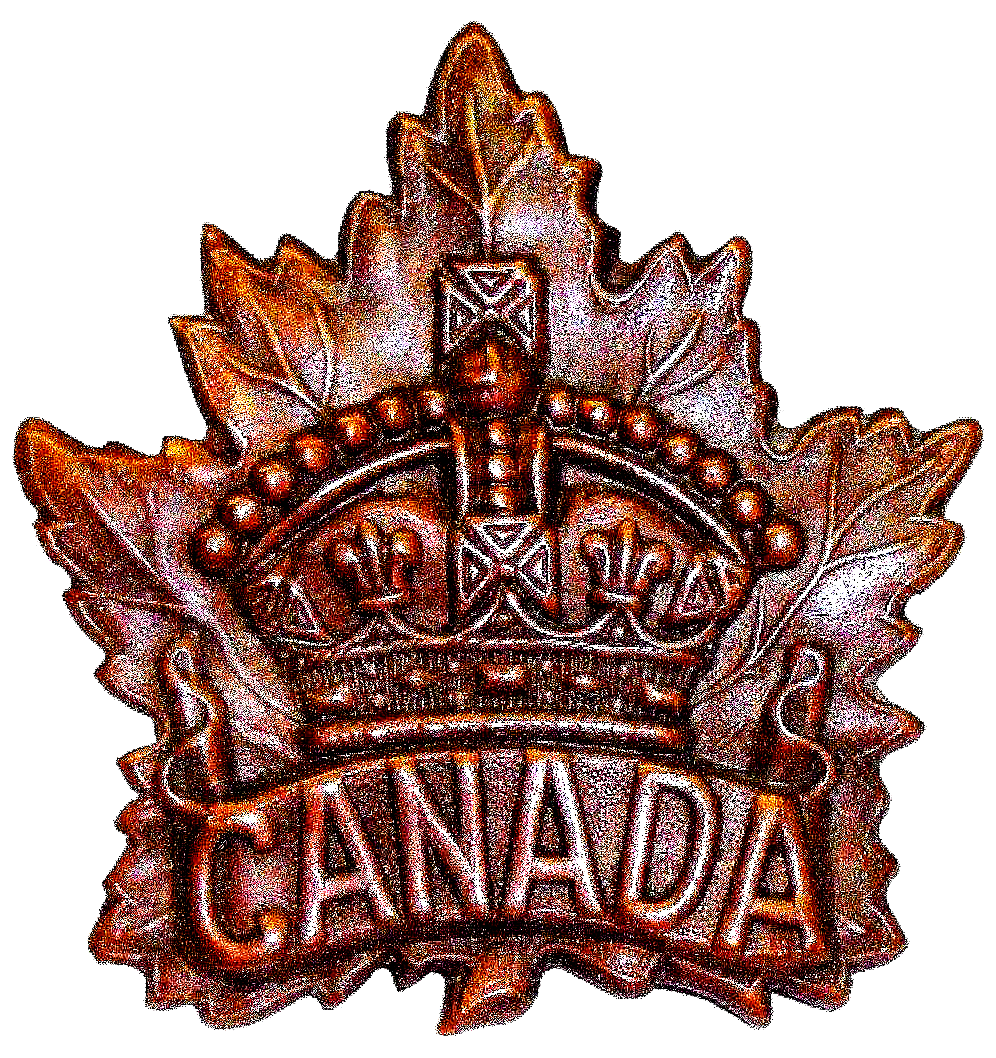
.png
)
.png)
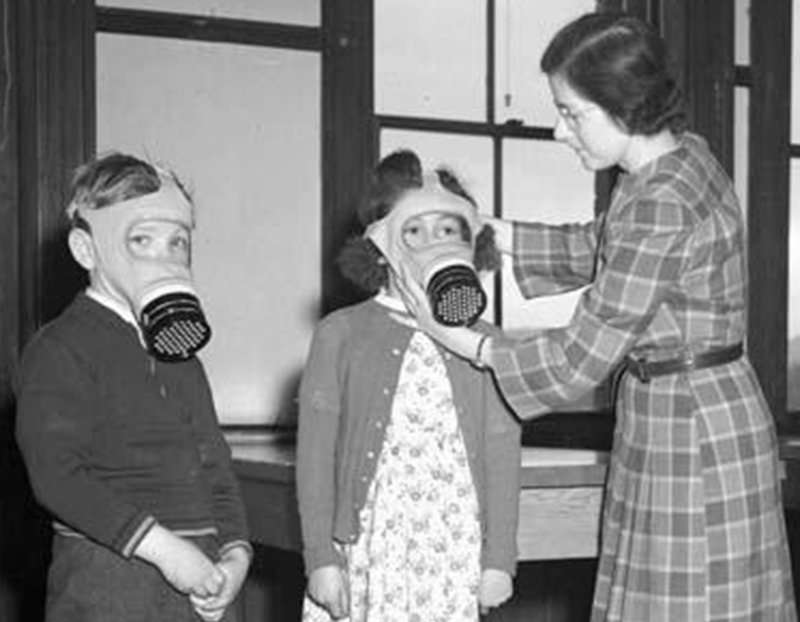
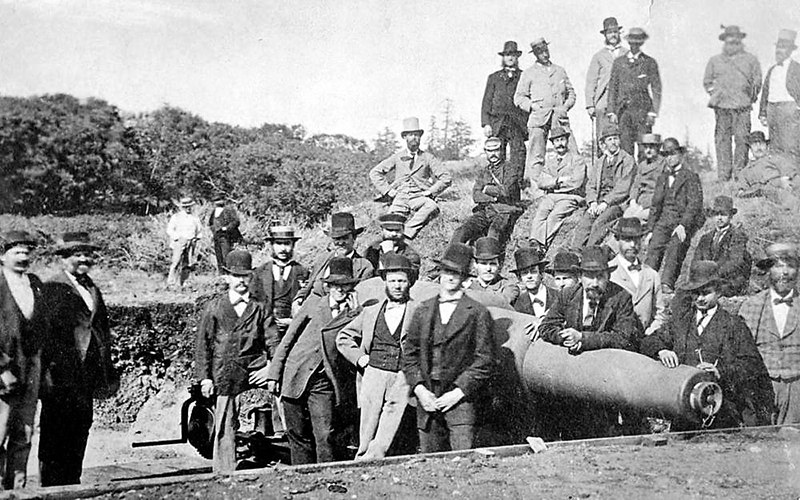
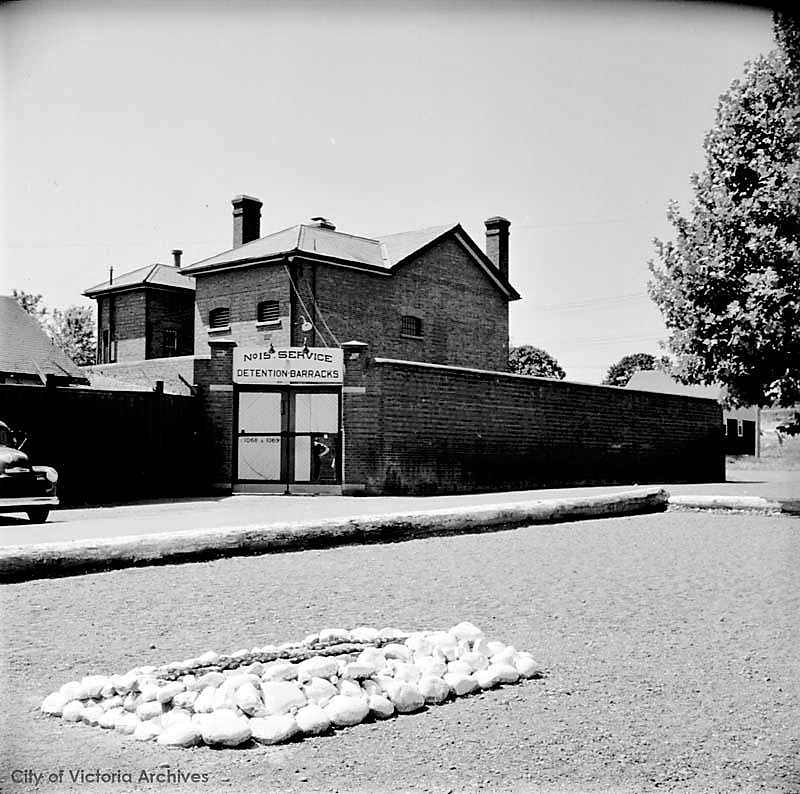
.png)
